The Business Model Canvas Essay
The Business Model Canvas (BMC) can be defined as a tool that is used in the generation of a business model. “The BMC is made up of nine building blocks forming a chart that describes a firms value proposition, infrastructure, customers, finances, resources, channels, revenue streams and cost structure”(Shaw 2011).
I am going to describe the business of Spotify.com using the BMC. Spotify is a company that helps its customers get the best music collection for their phones and personal computers. It is a company with a large dataset of music tracks. It also enables its customers to browse music from their friend’s collection lists and from music celebrities (Pigneru, 2012).

Key Partners
This refers to the partners that we do business with. They include ,Marantz, Phillips, Onkyo, Sonos, Samsung, Denon, WD, Boxee, Morpher and logitech.
Key Activities
This involves the main mission as to the existence of the company. Theses are the activities that give a company the meaning for its existence. The key activities for spotify are divided into three;
- Production – This involves producing the music and distributing it to the customers and loading it up to their website.
- Problem solving – Solving problems faced by customers by making use of qualified IT team. Making sure there is enough music in the system.
- Platform management.
Value Propositions
This involves value delivered to customers.
Customer Relationship
This is the association between the company and its clients.
Customer Segments
This covers areas where customers are found in the market.
Key Resources
This refers to the resources that make up our value proposition and which will generate revenue and at the same time reduce costs. The resources aim at improving customer relationships and in the distribution of products.
This are the channels of distribution used to get to our customers. It involves using the channels that enable us reach our customers best and in the shortest time. The channel aims at;
- Awareness – Creating awareness to customers about our products.
- Evaluation – By allowing our customers to evaluate us by having questionnaires that give feedback on our products and services. And having a balance score card for our employees.
- Purchase – These refers to the ease with which our customers can pay for our products which can be done through bankers cheque, credit cards, internet money transfer, money orders or in cash.
- After sales service – Refers the support given to the customers after the purchase. This includes free delivery to their locations, installation, offering warranties and guaranties and doing regular check-ups (Spinellli, 2012).
Cost structure
This touches on the cost structure of our business and creating value for money.
Revenue streams
This refers to the income generated from the business. It involves ethical business practices by charging customers fairly. The customers can pay for this revenue streams through negotiated bargaining or buying in the real market prices.
Business model pattern
The business model of Spotify has a long tail business model patterns.
Long tail business
This is a business model that focuses on selling a few products to a large number of clients. This is because the business is targeting a market that is not very profitable in terms of sales and targeting a specific market can be too costly (Pignerur, 2012). This business mode is working for Spotify because;
- There is democratisation in the production of music in the industry. There is advanced technology that favours the company, and the technology was more costly years back. There are also cheap applications that enables customers download music and videos.
- There is democratisation in the distribution process. This has been made possible through the internet where the distribution costs are low, the inventory is always available in the internet, there is little communication and transaction overheads and the internet has opened up the niche market
- There is less costs of searching for the products in the market. This because Internet Service Providers (ISP) have lowered their costs. Therefore, it is easy for the niche market to get their products cheaply.
- The cost of running the business is low and the company can have unlimited number of clients from the mass market. The company can as well subsidize its costs for its loyal customers (svathy, 2012).
Business Model Canvas Designed for: Spotify.com Designed by:
List of References
Pignerur, A 2012, Business model Generation. A Handbook for visinories, Game changers, and challegers. John Wiley & Sons, New York.
Pigneru, A 2012, anaging creativity and innovation. New york: John Wiley & Sons.
Shaw, J 2011, Business Model Canvas. Web.
Spinellli, J, 2012, New venture creation -Entrepreneurship for the 21th century. Mc Graw Hill, New York.
Svathy, S 2012, Business Model Canvas. Web.
- Chicago (A-D)
- Chicago (N-B)
IvyPanda. (2024, April 2). The Business Model Canvas. https://ivypanda.com/essays/the-business-model-canvas-essay/
"The Business Model Canvas." IvyPanda , 2 Apr. 2024, ivypanda.com/essays/the-business-model-canvas-essay/.
IvyPanda . (2024) 'The Business Model Canvas'. 2 April.
IvyPanda . 2024. "The Business Model Canvas." April 2, 2024. https://ivypanda.com/essays/the-business-model-canvas-essay/.
1. IvyPanda . "The Business Model Canvas." April 2, 2024. https://ivypanda.com/essays/the-business-model-canvas-essay/.
Bibliography
IvyPanda . "The Business Model Canvas." April 2, 2024. https://ivypanda.com/essays/the-business-model-canvas-essay/.
- "The Real Transformers" by Robin Marantz Henig
- BMC Company's Organizational Performance and Culture in Practice
- Conflict in Syria: Opportunity for Future Democratisation?
- Strategy of Google Company
- Strategic Report for Spotify
- Brand for Marking Highway Centerlines and Lanes
- Benefits of Remote Working to a Company
- Time Warner Company Strategic Management
- The Spotify Company Analysis & Recommendations
- Spotify’s Response to the Joe Rogan Situation
- MRP: Riordan Electric Fans
- Starbucks Coffee Marketing
- Warfare in the High Skies
- The Tool Box Project
Business Model Canvas: Explained with Examples
Got a new business idea, but don’t know how to put it to work? Want to improve your existing business model? Overwhelmed by writing your business plan? There is a one-page technique that can provide you the solution you are looking for, and that’s the business model canvas.
In this guide, you’ll have the Business Model Canvas explained, along with steps on how to create one. All business model canvas examples in the post can be edited online.
What is a Business Model Canvas
A business model is simply a plan describing how a business intends to make money. It explains who your customer base is and how you deliver value to them and the related details of financing. And the business model canvas lets you define these different components on a single page.
The Business Model Canvas is a strategic management tool that lets you visualize and assess your business idea or concept. It’s a one-page document containing nine boxes that represent different fundamental elements of a business.
The business model canvas beats the traditional business plan that spans across several pages, by offering a much easier way to understand the different core elements of a business.
The right side of the canvas focuses on the customer or the market (external factors that are not under your control) while the left side of the canvas focuses on the business (internal factors that are mostly under your control). In the middle, you get the value propositions that represent the exchange of value between your business and your customers.
The business model canvas was originally developed by Alex Osterwalder and Yves Pigneur and introduced in their book ‘ Business Model Generation ’ as a visual framework for planning, developing and testing the business model(s) of an organization.

What Are the Benefits of Using a Business Model Canvas
Why do you need a business model canvas? The answer is simple. The business model canvas offers several benefits for businesses and entrepreneurs. It is a valuable tool and provides a visual and structured approach to designing, analyzing, optimizing, and communicating your business model.
- The business model canvas provides a comprehensive overview of a business model’s essential aspects. The BMC provides a quick outline of the business model and is devoid of unnecessary details compared to the traditional business plan.
- The comprehensive overview also ensures that the team considers all required components of their business model and can identify gaps or areas for improvement.
- The BMC allows the team to have a holistic and shared understanding of the business model while enabling them to align and collaborate effectively.
- The visual nature of the business model canvas makes it easier to refer to and understand by anyone. The business model canvas combines all vital business model elements in a single, easy-to-understand canvas.
- The BMC can be considered a strategic analysis tool as it enables you to examine a business model’s strengths, weaknesses, opportunities, and challenges.
- It’s easier to edit and can be easily shared with employees and stakeholders.
- The BMC is a flexible and adaptable tool that can be updated and revised as the business evolves. Keep your business agile and responsive to market changes and customer needs.
- The business model canvas can be used by large corporations and startups with just a few employees.
- The business model canvas effectively facilitates discussions among team members, investors, partners, customers, and other stakeholders. It clarifies how different aspects of the business are related and ensures a shared understanding of the business model.
- You can use a BMC template to facilitate discussions and guide brainstorming brainstorming sessions to generate insights and ideas to refine the business model and make strategic decisions.
- The BMC is action-oriented, encouraging businesses to identify activities and initiatives to improve their business model to drive business growth.
- A business model canvas provides a structured approach for businesses to explore possibilities and experiment with new ideas. This encourages creativity and innovation, which in turn encourages team members to think outside the box.
How to Make a Business Model Canvas
Here’s a step-by-step guide on how to create a business canvas model.
Step 1: Gather your team and the required material Bring a team or a group of people from your company together to collaborate. It is better to bring in a diverse group to cover all aspects.
While you can create a business model canvas with whiteboards, sticky notes, and markers, using an online platform like Creately will ensure that your work can be accessed from anywhere, anytime. Create a workspace in Creately and provide editing/reviewing permission to start.
Step 2: Set the context Clearly define the purpose and the scope of what you want to map out and visualize in the business model canvas. Narrow down the business or idea you want to analyze with the team and its context.
Step 3: Draw the canvas Divide the workspace into nine equal sections to represent the nine building blocks of the business model canvas.
Step 4: Identify the key building blocks Label each section as customer segment, value proposition, channels, customer relationships, revenue streams, key resources, key activities, and cost structure.
Step 5: Fill in the canvas Work with your team to fill in each section of the canvas with relevant information. You can use data, keywords, diagrams, and more to represent ideas and concepts.
Step 6: Analyze and iterate Once your team has filled in the business model canvas, analyze the relationships to identify strengths, weaknesses, opportunities, and challenges. Discuss improvements and make adjustments as necessary.
Step 7: Finalize Finalize and use the model as a visual reference to communicate and align your business model with stakeholders. You can also use the model to make informed and strategic decisions and guide your business.
What are the Key Building Blocks of the Business Model Canvas?
There are nine building blocks in the business model canvas and they are:
Customer Segments
Customer relationships, revenue streams, key activities, key resources, key partners, cost structure.
- Value Proposition
When filling out a Business Model Canvas, you will brainstorm and conduct research on each of these elements. The data you collect can be placed in each relevant section of the canvas. So have a business model canvas ready when you start the exercise.

Let’s look into what the 9 components of the BMC are in more detail.
These are the groups of people or companies that you are trying to target and sell your product or service to.
Segmenting your customers based on similarities such as geographical area, gender, age, behaviors, interests, etc. gives you the opportunity to better serve their needs, specifically by customizing the solution you are providing them.
After a thorough analysis of your customer segments, you can determine who you should serve and ignore. Then create customer personas for each of the selected customer segments.

There are different customer segments a business model can target and they are;
- Mass market: A business model that focuses on mass markets doesn’t group its customers into segments. Instead, it focuses on the general population or a large group of people with similar needs. For example, a product like a phone.
- Niche market: Here the focus is centered on a specific group of people with unique needs and traits. Here the value propositions, distribution channels, and customer relationships should be customized to meet their specific requirements. An example would be buyers of sports shoes.
- Segmented: Based on slightly different needs, there could be different groups within the main customer segment. Accordingly, you can create different value propositions, distribution channels, etc. to meet the different needs of these segments.
- Diversified: A diversified market segment includes customers with very different needs.
- Multi-sided markets: this includes interdependent customer segments. For example, a credit card company caters to both their credit card holders as well as merchants who accept those cards.
Use STP Model templates for segmenting your market and developing ideal marketing campaigns
Visualize, assess, and update your business model. Collaborate on brainstorming with your team on your next business model innovation.
In this section, you need to establish the type of relationship you will have with each of your customer segments or how you will interact with them throughout their journey with your company.
There are several types of customer relationships
- Personal assistance: you interact with the customer in person or by email, through phone call or other means.
- Dedicated personal assistance: you assign a dedicated customer representative to an individual customer.
- Self-service: here you maintain no relationship with the customer, but provides what the customer needs to help themselves.
- Automated services: this includes automated processes or machinery that helps customers perform services themselves.
- Communities: these include online communities where customers can help each other solve their own problems with regard to the product or service.
- Co-creation: here the company allows the customer to get involved in the designing or development of the product. For example, YouTube has given its users the opportunity to create content for its audience.
You can understand the kind of relationship your customer has with your company through a customer journey map . It will help you identify the different stages your customers go through when interacting with your company. And it will help you make sense of how to acquire, retain and grow your customers.

This block is to describe how your company will communicate with and reach out to your customers. Channels are the touchpoints that let your customers connect with your company.
Channels play a role in raising awareness of your product or service among customers and delivering your value propositions to them. Channels can also be used to allow customers the avenue to buy products or services and offer post-purchase support.
There are two types of channels
- Owned channels: company website, social media sites, in-house sales, etc.
- Partner channels: partner-owned websites, wholesale distribution, retail, etc.
Revenues streams are the sources from which a company generates money by selling their product or service to the customers. And in this block, you should describe how you will earn revenue from your value propositions.
A revenue stream can belong to one of the following revenue models,
- Transaction-based revenue: made from customers who make a one-time payment
- Recurring revenue: made from ongoing payments for continuing services or post-sale services
There are several ways you can generate revenue from
- Asset sales: by selling the rights of ownership for a product to a buyer
- Usage fee: by charging the customer for the use of its product or service
- Subscription fee: by charging the customer for using its product regularly and consistently
- Lending/ leasing/ renting: the customer pays to get exclusive rights to use an asset for a fixed period of time
- Licensing: customer pays to get permission to use the company’s intellectual property
- Brokerage fees: revenue generated by acting as an intermediary between two or more parties
- Advertising: by charging the customer to advertise a product, service or brand using company platforms
What are the activities/ tasks that need to be completed to fulfill your business purpose? In this section, you should list down all the key activities you need to do to make your business model work.
These key activities should focus on fulfilling its value proposition, reaching customer segments and maintaining customer relationships, and generating revenue.
There are 3 categories of key activities;
- Production: designing, manufacturing and delivering a product in significant quantities and/ or of superior quality.
- Problem-solving: finding new solutions to individual problems faced by customers.
- Platform/ network: Creating and maintaining platforms. For example, Microsoft provides a reliable operating system to support third-party software products.
This is where you list down which key resources or the main inputs you need to carry out your key activities in order to create your value proposition.
There are several types of key resources and they are
- Human (employees)
- Financial (cash, lines of credit, etc.)
- Intellectual (brand, patents, IP, copyright)
- Physical (equipment, inventory, buildings)
Key partners are the external companies or suppliers that will help you carry out your key activities. These partnerships are forged in oder to reduce risks and acquire resources.
Types of partnerships are
- Strategic alliance: partnership between non-competitors
- Coopetition: strategic partnership between partners
- Joint ventures: partners developing a new business
- Buyer-supplier relationships: ensure reliable supplies
In this block, you identify all the costs associated with operating your business model.
You’ll need to focus on evaluating the cost of creating and delivering your value propositions, creating revenue streams, and maintaining customer relationships. And this will be easier to do so once you have defined your key resources, activities, and partners.
Businesses can either be cost-driven (focuses on minimizing costs whenever possible) and value-driven (focuses on providing maximum value to the customer).
Value Propositions
This is the building block that is at the heart of the business model canvas. And it represents your unique solution (product or service) for a problem faced by a customer segment, or that creates value for the customer segment.
A value proposition should be unique or should be different from that of your competitors. If you are offering a new product, it should be innovative and disruptive. And if you are offering a product that already exists in the market, it should stand out with new features and attributes.
Value propositions can be either quantitative (price and speed of service) or qualitative (customer experience or design).

What to Avoid When Creating a Business Model Canvas
One thing to remember when creating a business model canvas is that it is a concise and focused document. It is designed to capture key elements of a business model and, as such, should not include detailed information. Some of the items to avoid include,
- Detailed financial projections such as revenue forecasts, cost breakdowns, and financial ratios. Revenue streams and cost structure should be represented at a high level, providing an overview rather than detailed projections.
- Detailed operational processes such as standard operating procedures of a business. The BMC focuses on the strategic and conceptual aspects.
- Comprehensive marketing or sales strategies. The business model canvas does not provide space for comprehensive marketing or sales strategies. These should be included in marketing or sales plans, which allow you to expand into more details.
- Legal or regulatory details such as intellectual property, licensing agreements, or compliance requirements. As these require more detailed and specialized attention, they are better suited to be addressed in separate legal or regulatory documents.
- Long-term strategic goals or vision statements. While the canvas helps to align the business model with the overall strategy, it should focus on the immediate and tangible aspects.
- Irrelevant or unnecessary information that does not directly relate to the business model. Including extra or unnecessary information can clutter the BMC and make it less effective in communicating the core elements.
What Are Your Thoughts on the Business Model Canvas?
Once you have completed your business model canvas, you can share it with your organization and stakeholders and get their feedback as well. The business model canvas is a living document, therefore after completing it you need to revisit and ensure that it is relevant, updated and accurate.
What best practices do you follow when creating a business model canvas? Do share your tips with us in the comments section below.
Join over thousands of organizations that use Creately to brainstorm, plan, analyze, and execute their projects successfully.
FAQs About the Business Model Canvas
- Use clear and concise language
- Use visual-aids
- Customize for your audience
- Highlight key insights
- Be open to feedback and discussion
More Related Articles

Amanda Athuraliya is the communication specialist/content writer at Creately, online diagramming and collaboration tool. She is an avid reader, a budding writer and a passionate researcher who loves to write about all kinds of topics.
Business Model Canvas [+ Template]: How-to & Examples
Home » Business Model Canvas | 🕑
Gust de Backer
November 6, 2023.
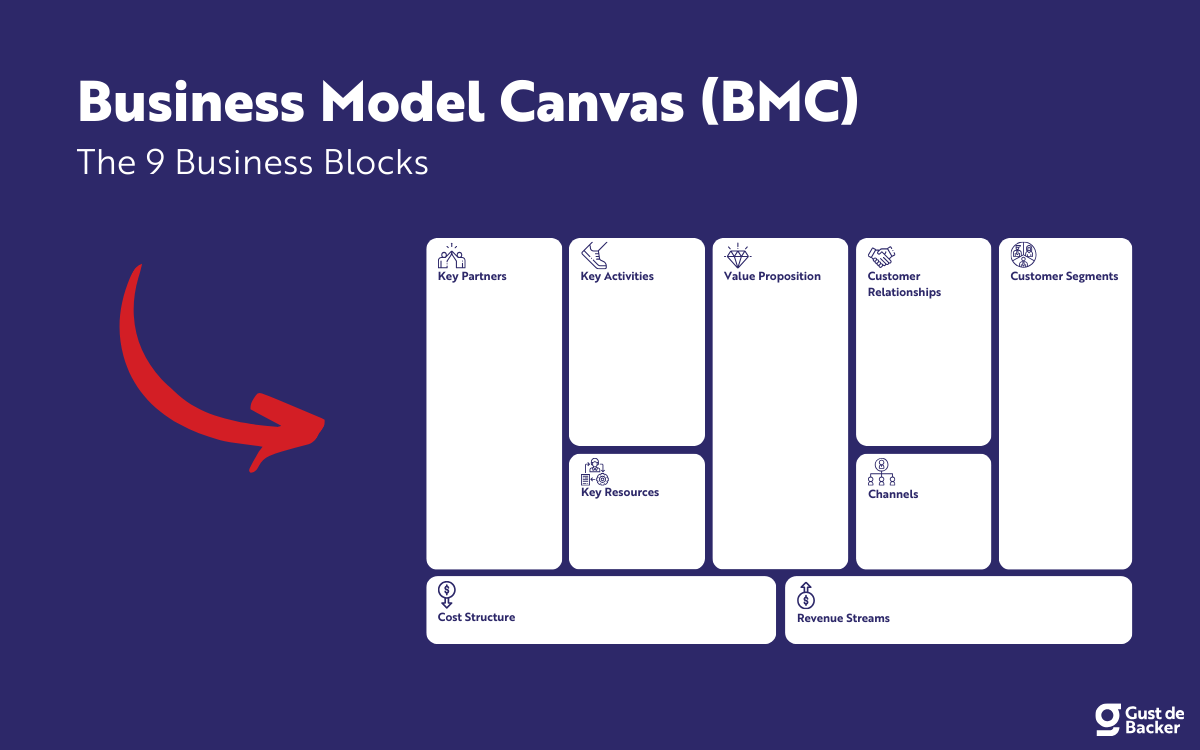
The Business Model Canvas is your complete business on 1 a4’s sheet…
How do you make sure you keep an overview in the chaos and also innovate in time?
In this article, I’ll show you:
- What the Business Model Canvas is
- How to fill in the Business Model Canvas
- And I’ll show you how to innovate the Business Model Canvas
Let’s get started…
Table of Contents
Business Model Canvas
The business model describes in concrete terms how an organization creates value, delivers it and how it makes money from this.
There are 9 blocks that the Business Model Canvas consists of:

Here, the left part of the canvas focuses on efficiency and the right part on value:
We are now going to cover the 9 different components…
1. Customer segments
An organization serves one or more customer segments.
Customer segments describe the different people or organizations that your company wants to reach and serve.
No business can survive without customers, to better connect with customers it is useful to divide the group of customers into different target groups.
A customer segment can consist of demographic characteristics:
Geographical characteristics:
But also from other types of characteristics:
- Digital intelligence
- Mileage awareness
Beyond the customer segment, it is also useful to consider what type of market you want to enter:
- New market ( blue ocean )
- Existing market ( red ocean )
- New segment in an existing market (niche)
2. Value proposition
A company must solve a problem with a clear value proposition.
The value proposition block describes how a product creates value for a specific customer segment, or in other words shows the benefits your company delivers to the customer.
The value proposition is the reason why customers choose one company over another.
There are basically 11 types of value propositions you can offer:
- Newness : something that is not possible at the moment. You create a market and push the boundaries of what is currently possible.
- Performance : you are going to do something better or faster than the existing competition.
- Customization : personalizing an experience.
- Getting the job done : you focus on a sub-activity of the customer and you take this completely out of their hands.
- Design : if you respond to the form or functionality of your product, we talk about the design.
- Price : if you play on price then you focus on the segment in a market that is not willing to pay extra to your competitors. It is important that the market is large enough.
- Brand/status : if people want to show that they are wearing your brand, you play on brand and status.
- Cost reduction : you save the customer costs.
- Risk reduction : You reduce the risk of something for the customer.
- Accessibility : you provide access to something a customer previously had little to no access to.
- Convenience/usability : the convenience for a user or customer.
3. Channels
Value propositions are delivered using communication, distribution and sales channels.
The channels describe the way a company communicates with the customers and how it actually delivers the value proposition. Thus, there are 3 types of channels involved:
- Communication channels
- Distribution channels
- Sales channels
So each channel offers one or more touchpoints, you could map these in the way below:

Here, of course, you can also differentiate between direct (owned) and indirect (partner) channels.
Tip : use the Pirate Funnel Canvas to map out the customer journey figures.
4. Customer Relationships
An organization must establish and maintain relationships with each customer segment.
This section describes the type of relationship you have with the customer, these can range from personal to automated.
The motivation for having a relationship with a (potential) customer can be as follows:
- Customer acquisition
- Customer retention
- Selling more (up-selling)
There are several types of relationships you can have with the customer:
- Personal assistant : the customer can have contact with a person, this can be through call centers, email or perhaps on location.
- Own personal assistant : one or more people in your company are assigned to a specific customer. This is the most in-depth customer relationship you can have and usually involves a longer period of time.
- Self-service : ensuring that customers can help themselves.
- Automated service : automated processes that ensure the customer is helped.
- Community : an online community that shares knowledge and helps others along the way can also be a form of service.
- Co-creation : helping users to strengthen the relationship by thinking or collaborating on a product or service.
5. Revenue stream
A revenue stream occurs when the value proposition is successfully delivered to the customer.
The revenue stream represents the money a company makes from a customer segment. In this, it is important to ensure that the revenue stream closely matches the value the customer receives.
There are quite a few revenue models and pricing strategies you can choose, but these are the most common:
- Hourly rate : you get paid by the hour.
- Transaction model : you get paid per sale.
- Subscription model : you get paid on a periodic basis each time.
- Advertising model : you make money selling advertising space.
- Rental model : you make money from renting out something.
- Consumption model : you make money from the amount a user consumes.
- Mediation model : you make money from referring users or matching supply and demand.
- Production model : you produce something on behalf of a party.
- Donation model : you make money from donations.
- Freemium model : you offer a free version first and then make money from the paid version.
6. Core Resources
The key resources needed to keep the business running.
The resources you need to create and deliver your value proposition, reach a market, maintain customer relationships and make money are your core resources. These resources can be:
- Intellectual
- Or be rented/purchased from external partners
7. Core Activities
The main activities that the company engages in.
The most important tasks a company does to make the business model work are core activities. Core activities can consist of 3 different categories:
- Manufacturing : designing making and delivering a product in specific quantities, is often used by manufacturing companies.
- Problem solving : solutions to specific customer problems, is often used by service related companies.
- Platform/network : networks, matchmakers, software and even brands can serve as a platform. For example, VISA is a platform for businesses, customers and banks.
8. Key Partners
Partners who provide key activities or resources.
The network of suppliers and partners that help realize your business model are your key partners.
It is important to have partners because they allow your company to optimize its business model, reduce risk, and help you get additional resources.
There are 4 types of partnerships:
- Strategic partnership between non-competitors.
- Coopetition , strategic partnership with a competitor.
- Joint venture to attract new business.
- Buyer-supplier to maintain reliable inventory.
There are three types of motivations you may have for entering into a partnership:
- Optimization and economy of scale : a partnership to reduce costs, because a company simply cannot produce all the resources itself.
- Reduction of risk and uncertainty : to reduce risk in a highly competitive market.
- Acquisition of specific resources and activities : attract more opportunities to you by partnering with different companies, this may be in terms of knowledge, licenses or access to customers.
9. Cost Structure
Different components in the Business Model Canvas will create costs.
All costs in a business model that are necessary to keep the business running fall into the cost structure.
There are two types of cost structures:
- Cost-driven : business models that focus on reducing costs whenever possible. Often the cost-driven cost structure comes in combination with a value proposition where a company claims to be the cheapest, this may include a lot of automation and/or a lot of outsourcing.
- Value-driven : these companies are less concerned with cost and focus on creating value. This cost structure is often used with premium value propositions and/or when a lot of personalization is involved.
A cost structure has 4 different characteristics:
- Fixed costs : costs that are always the same regardless of the volume of products or services.
- Variable costs : costs that are related to the volume in which products or services are delivered.
- Economies of scale : cost advantages that a firm gets when it produces or purchases more volume.
- Economies of scope : cost advantages a company gains from having a large scope of activities. For example, think of offering multiple products because you already have the marketing or distribution channels in place.
Business Model Canvas examples

How to manage the Business Model Canvas
First, download the Business Model Canvas:

Goede keus! Check je mail voor de resources...
Make sure the company understands the value of the Business Model Canvas and establish a team to work with it.
Immerse yourself and your team in the market and the organisation so you have enough knowledge to fill in the Business Model Canvas.
Complete several Business Model Canvases and test your assumptions where possible.
Implement the Business Model Canvas you have chosen.
Continuously evaluate if your Business Model Canvas is up-to-date, adjust where possible and try to innovate in time.
Business Model Canvas innovation
Innovate in your Business Model Canvas in the following ways:
- Unmet demand in a market : find a market in which you can fulfill an unmet demand.
- Bring something new to the market : bring a new technology, product or service to the market or leverage existing intellectual property.
- Improve the market : improve or disrupt an existing market.
- Create a market : create a new market.
There are several challenges involved here:
- Finding the right model.
- Testing the model before launching on a large scale.
- Getting the market to adopt the new model.
- Continuously adjusting the model in response to feedback from the market.
- Dealing with uncertainty.
In this you can distinguish between:
The exploit’s part it’s biggest risk is not innovating in time and in the explore part uncertainty is the biggest risk. In addition, it is important to pursue the right culture, think for example of ‘The Culture Map’ .
And now you…
Now I’m curious, how far along are you with your business?
Are you at the point of innovating the Business Model Canvas (BMC) or have you yet to draft your first BMC?
Let me know in a comment.
P.S. if you would like additional help let me know at [email protected]
Frequently Asked Questions
The Business Model Canvas describes in concrete terms how an organisation creates value, delivers it and how it makes money from it.
You use the Business Model Canvas to map out your entire business, it is also easier to talk to stakeholders about your business if you can present it on 1 a4’s.
Core activities are the activities that keep your business running.
You can describe a Business Model in a Business Model Canvas, using 9 blocks to map out your complete business.
The BMC helps companies to understand their business, using 9 blocks you have concrete insight in the most important parts in your business. The BMC helps stakeholders to understand your business in an easy way.
You start with the customer segments, then you move to the value proposition, then you move to the channels, customer relationships, revenue stream, core resources, core activities, key partners, and conclude at the cost structure.
I try to help business surpass their growth ceiling with my content.
Sounds interesting?
Let’s connect on LinkedIn!
Business Model Canvas | Business Strategy | Market Research | Marketing and Sales | Pricing Strategy | Product-market Fit | Revenue Models | TAM SAM SOM Model | Treacy and Wiersema | Value Proposition Canvas
Gust’s Must-Reads 👇🏼
- TAM SAM SOM
- Value Proposition
- Brainstorming
- Decision Making Unit
- Product-Market Fit
- North Star Metric
- Market Research
- Customer Development
- Growth Hacking
- Brand Identity
- Customer Journey
- Account-Based Marketing
![business model canvas essay OGSM Model (2024): How-to & Examples [+ Template]](https://gustdebacker.com/wp-content/uploads/2023/11/OGSM-Model.png)
OGSM Model (2024): How-to & Examples [+ Template]
OGSM Model: a solution that helps with strategic planning and goal setting. You know where you want to go, but you don't have a clear picture of how you're going to get there. Ideas and goals are often not realized because there is no clear planning associated with...
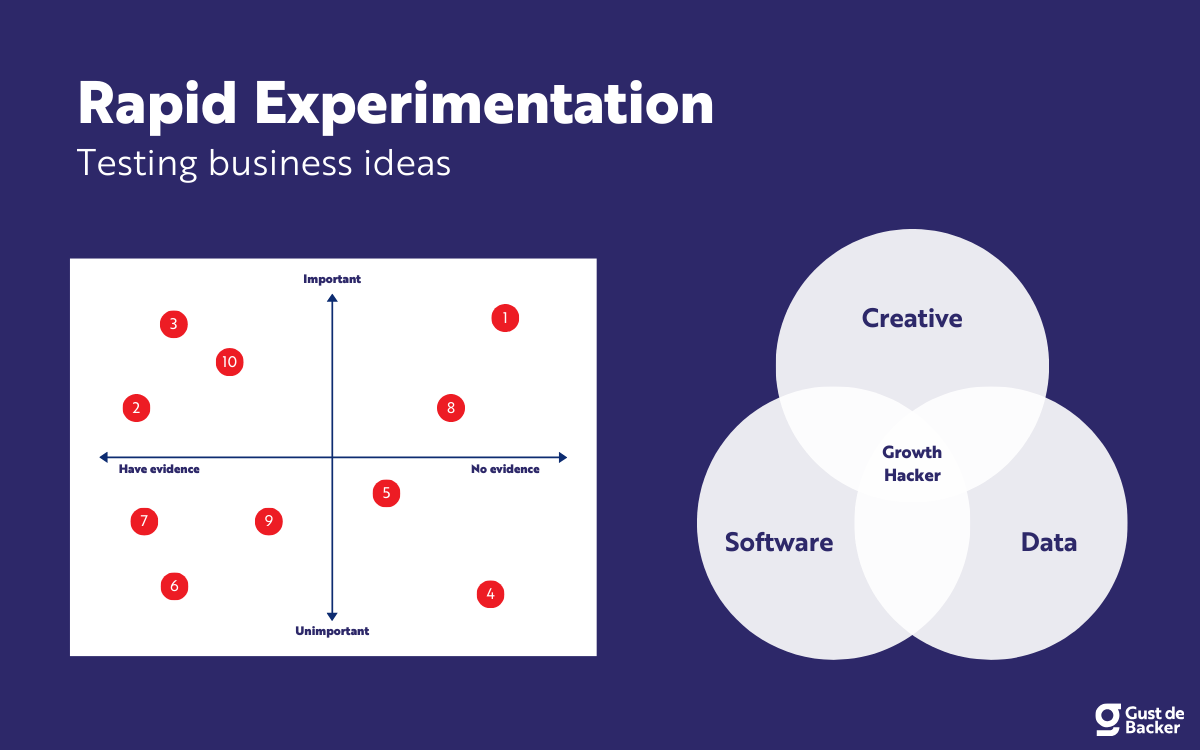
Rapid Experimentation: The Road To Innovation (Complete Guide)
You read it left and right, companies that owe much of their success to experimentation.... Of course, experimentation can be understood in a hugely broad way, so in this article I'm going to get you started with: Understanding why experimentation is important...
![business model canvas essay Cognitive Biases (2024): Complete List of 151 Biases [Psychology]](https://gustdebacker.com/wp-content/uploads/2023/11/151-Cognitive-Biases.png)
Cognitive Biases (2024): Complete List of 151 Biases [Psychology]
Cognitive biases, there are so many of them... Decisions we make based on emotion, cognitive biases are irrational 'errors' that are programmed into people's brains and affect the decision-making process. Plenty of different articles have been written and an entire...
I think this training will help me very much and I need it also thanks for putting this online.
Thank you, Bernard!
Submit a Comment Cancel reply
Your email address will not be published. Required fields are marked *
Save my name, email, and website in this browser for the next time I comment.
Submit Comment
You have Successfully Subscribed!
Home — Essay Samples — Business — Business Analysis — Business Model Canvas
Business Model Canvas
- Categories: Business Analysis Technology in Business
About this sample

Words: 679 |
Published: Sep 19, 2019
Words: 679 | Page: 1 | 4 min read
Works Cited
- Lancelott Gutierrezcampbell. (2017). The business model canvas: Let your business thrive with this simple model. CreateSpace Independent Publishing Platform.
- MFS. (n.d.). Business plan. Retrieved from https://www.slideshare.net/ErshadulIslam/business-plan-237082609
- Porter, M. E. (1985). Competitive advantage: Creating and sustaining superior performance. Free Press.
- Prahalad, C. K., & Hamel, G. (1990). The core competence of the corporation. Harvard business review, 68(3), 79-91.
- Ries, E. (2011). The lean startup: How today’s entrepreneurs use continuous innovation to create radically successful businesses. Crown Business.
- Schmidt, M. (2012). Business model innovation: Developing sustainable business models. BoD–Books on Demand.
- Teece, D. J. (2010). Business models, business strategy and innovation. Long range planning, 43(2-3), 172-194.
- Wirtz, B. W., & Schilke, O. (2018). Business model innovation: Towards an integrated future research agenda. Journal of Business Research, 86, 225-238.
- Zott, C., & Amit, R. (2010). Business model design: An activity system perspective. Long range planning, 43(2-3), 216-226.
- Zott, C., Amit, R., & Massa, L. (2011). The business model: Recent developments and future research. Journal of management, 37(4), 1019-1042.

Cite this Essay
Let us write you an essay from scratch
- 450+ experts on 30 subjects ready to help
- Custom essay delivered in as few as 3 hours
Get high-quality help

Verified writer
- Expert in: Business

+ 120 experts online
By clicking “Check Writers’ Offers”, you agree to our terms of service and privacy policy . We’ll occasionally send you promo and account related email
No need to pay just yet!
Related Essays
2 pages / 1052 words
1 pages / 638 words
1 pages / 388 words
7 pages / 2346 words
Remember! This is just a sample.
You can get your custom paper by one of our expert writers.
121 writers online

Still can’t find what you need?
Browse our vast selection of original essay samples, each expertly formatted and styled
Related Essays on Business Analysis
This report was initiated to find out why Eastman Kodak was wiped out from the photography industry, evaluate Kodak’s digital imaging strategy and why it failed, provide better alternatives to the strategy and finally point out [...]
Organizations that need to cement their place regarding competitive advantage need to put in place strategies that will make it possible for remaining efficient. Productivity and high levels of innovation are also important when [...]
Glo-Bus, a global business simulation game, offers college students a unique opportunity to gain hands-on experience in making strategic business decisions. The purpose of the Glo-Bus Final Report is to critically evaluate the [...]
Panda Express is one of the fastest casual restaurant chains delivering American Chinese cuisine all over headquartered at Rosemead, California. It has almost 2000 outlets in 50 cities of US, the District of Columbia, Puerto [...]
Fast food is a type of food prepared quickly and served as a takeaway or quick meal usually involving reheating cooked meals. It was first cited in Britain in 1860 with the first fish and chips shops. In the 1950s, drive-through [...]
Stakeholders are those who are directly or indirectly related to the business and also business can influence their life positively or negatively. Businesses success or failure can be result of their prosperity as well. For a [...]
Related Topics
By clicking “Send”, you agree to our Terms of service and Privacy statement . We will occasionally send you account related emails.
Where do you want us to send this sample?
By clicking “Continue”, you agree to our terms of service and privacy policy.
Be careful. This essay is not unique
This essay was donated by a student and is likely to have been used and submitted before
Download this Sample
Free samples may contain mistakes and not unique parts
Sorry, we could not paraphrase this essay. Our professional writers can rewrite it and get you a unique paper.
Please check your inbox.
We can write you a custom essay that will follow your exact instructions and meet the deadlines. Let's fix your grades together!
Get Your Personalized Essay in 3 Hours or Less!
We use cookies to personalyze your web-site experience. By continuing we’ll assume you board with our cookie policy .
- Instructions Followed To The Letter
- Deadlines Met At Every Stage
- Unique And Plagiarism Free
Home Blog Business What is a Business Model Canvas? Quick Guide + Examples

What is a Business Model Canvas? Quick Guide + Examples

Based on the work of Alexander Osterwalder, a Business Model Canvas , or BMC for short, is a diagram used to visualize a business model; it allows structured organization and a quick method of evaluation and reflection on the effectiveness of a Business Model. The use and study of Business Model Canvas Examples allows us to understand it in a complete way and apply it to different types of organizations.
The Role of the Business Model Canvas
What are the benefits of using a business model canvas, 1. customer segments, 2. value propositions, 3. customer relationships, 4. channels, 5. revenue streams, 6. key activities, 7. key resources, 8. key partnerships, 9. cost structure, the power of a bmc in entrepreneurship: visualize the business model, mcdonald’s.
- How to Utilize a Business Model Canvas for your Success
Business Model Canvas PowerPoint Templates
Whether it be in small business entrepreneurship or large corporate product launches, the business model sits at the center. The one thing that stands at the very heart of the daily operations of an organization, is a model that dictates where the opportunity lies and how the company effectively acts on it at each step in the process.
The very best professionals will have all of this knowledge and action driving their decisions. However, the original business model one may follow may not always be applicable to the obstacles that an organization faces, thus it’s incredibly useful to fully display organizational structure and operations.
The Business Model Canvas is a powerful tool for businesses of all sizes and industries. Here are some key benefits of using this visual framework:
Simplifies Complexity: Business models can be intricate, with various elements and interactions. The BMC simplifies this complexity by breaking down the model into nine essential building blocks. This visual representation makes it easier for entrepreneurs, team members, and stakeholders to grasp the core components of the business without getting lost in a lengthy business plan. It’s a powerful tool for distilling complex ideas into a clear, concise format.
Enhances Focus: When creating a BMC, you’re prompted to think critically about each building block, such as customer segments, value propositions, and revenue streams. This process encourages a deep understanding of how these components interact and depend on each other. By explicitly defining these elements, you gain a sharper focus on your business strategy and objectives. It helps you identify gaps, redundancies, or areas where your model can be refined.
Promotes Collaboration: The BMC is designed to be a collaborative tool. It’s not something a single person creates in isolation; instead, it encourages cross-functional teams to work together. Each team member can contribute their expertise to fill in the relevant sections. This collaborative approach ensures that everyone involved in the project shares a common understanding of the business model, which is essential for successful execution.
Iterative and Adaptable: Business environments are dynamic, and your business model should be too. The BMC supports an iterative approach, allowing you to make changes and updates as needed. For instance, if market conditions change, you can easily adjust your value propositions or customer segments. It’s a flexible tool that accommodates experimentation and learning. You can use it to test different assumptions and hypotheses about your business and refine your model accordingly.
Cost-Effective: Creating a traditional business plan can be a time-consuming and expensive process. In contrast, developing a BMC is a cost-effective alternative. It doesn’t require extensive resources or financial investments. This makes it particularly valuable for startups and small businesses with limited budgets. It’s a pragmatic way to initiate strategic planning, especially in the early stages of a venture when resources are scarce.
The Basics of the Business Model Canvas
Whether one is creating an all-new business model, comparing a pre-existing model, or adjusting a model to improve value, the BMC excels in keeping anyone invested in the business on track without wasting time and focus. By displaying only, the most critical pieces in business operations or a product, this tool is both a time saver and a method to sharpen your awareness of expectations vs. reality.
Here is the Business Model Canvas explained: There are nine sections in a BMC, each containing a specified topic of information that composes the core of any business model.
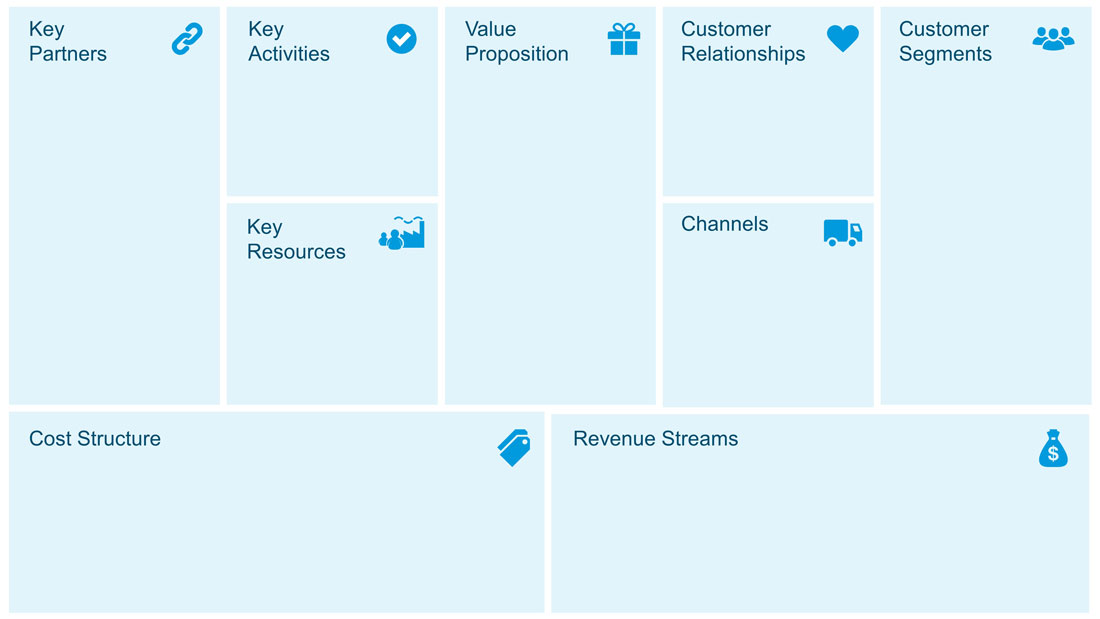
This section contains the information related to the core target audience that you are selling to. Simple and traditional segmentation analysis must be done to identify the top segments of the model. Start simple with questions like Which are the demographics of the major customer groups being targeted? Why are they going to be interested in the product or service? In essence, how well does the model comprehend who is being sold to? It is crucial that you identify clearly the segments as when facing reality, you will need to focus only in a few (1 or 2) to really test your model without a full operation in place.
Create a list of the unique business value propositions you will offer. Why is the idea or company valuable? What makes it stand above competitors? If there aren’t any direct competitors, what gaps are being filled in given markets?
This section could be extremely lengthy, depending on the business model, but should only contain the most central concepts at the heart of the model that attract customers or generate revenues. This section will contain the aspects of the business that relieve a customer’s pains. If you’re struggling to identify what is most important, consider using a Value Proposition Canvas, another easy-to-visual tool that helps establish your target audience with your strengths. Focus on solving a real pain for the segments identified.
The information of this section should refer to how to connect segments and the value proposition. During the analysis, you should be asking questions like How are customers convinced that your product or organization has the advertised special qualities? What methods are used to interact with them? How does an audience engage with each strategy in the product lifecycle? Additionally, how is customer engagement tracked?
Once the customer is convinced of the goods or services, how would you deliver them? This should include every step of the process it takes to make the financial transaction and value delivery possible. Is there a separate supplier? Who distributes the product? How is it displayed? Think about what the model requires from start to finish in order to make a sale.
If the customer connects with the product or service, and they want to proceed with doing business, then how does the actual exchange of money happen? How is the cash flow tracked? Are there any middlemen between the sale and the income to the business?
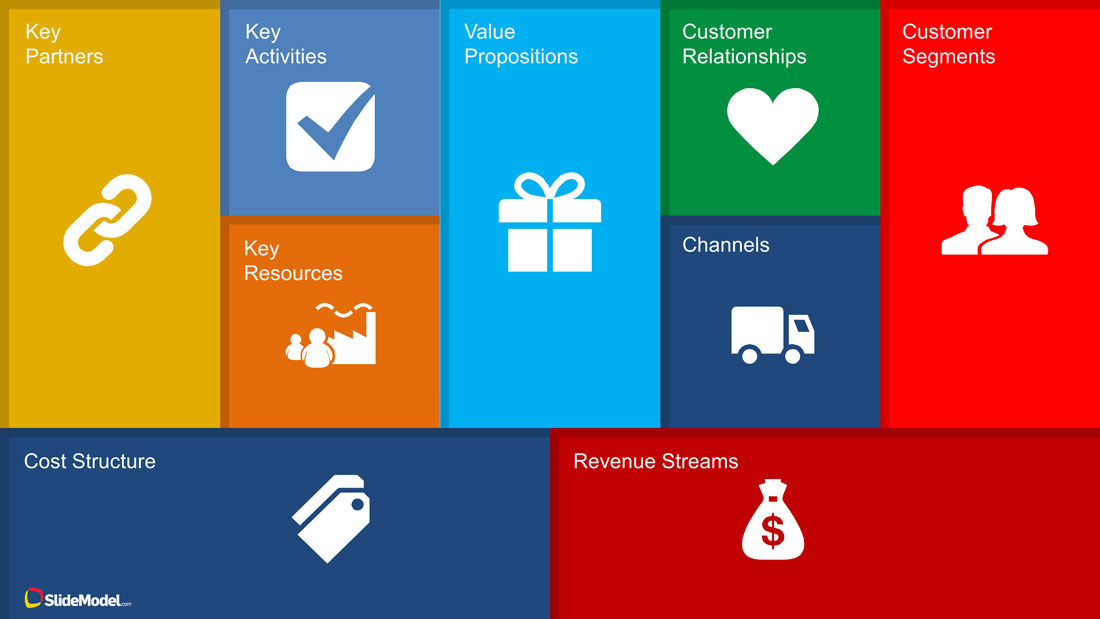
Source: Editable Business Model Canvas PowerPoint Template
This section should include specific activities that the organization will do to create value. Unlike the Value Propositions, it’s not just about a new product or business practice, but rather the day-to-day operations that each team will take.
Similar to Key Activities but focusing on assets that are used. Is there a special supplier? Is there access to any materials or a local storefront that puts you in an advantageous position? Do you have a special intellectual property or patent that introduces new knowledge into the niche?
For areas that may be lacking, or areas that are too costly for the business to manage by itself, what can be outsourced to partners to focus on? Which areas would it be more cost-efficient to hire from supporting businesses? Specifically, identify model strengths, maximize time and money on them, and move identified weaknesses to connected partners that can address them better or solve them altogether.
Finally, what are the major expenses in the model? Are they a flat fee, or are they a variable cost? This may factor into previous sections, like key activities, resources, and partnerships.
Additionally, how does this relate to the Revenue Streams? How will the predicted costs vs. the actual be monitored? Most importantly, what will be done if costs outweigh the incoming funds?
Creating a Business Model Canvas involves analyzing each of these sections individually and as a whole, and connecting the dots between them.
Introducing a new business or product to the world is no small undertaking, especially when you consider how much competition and other new ideas are thrown into the world on a regular basis.
This also means keeping the model current and responsive. A business model, after all, is only a well-educated guess on how to generate success from a demand. If reality does not match up to the prediction, then even the very best business models are useless. A BMC is your abstract representation of how a business delivers value to customers to help them solve problems.
Steven Blank’s book to entrepreneurs and business leaders, ‘Four Steps to the Epiphany’ , demonstrates the difference between those who watch and listen to their model in action, and those who convince themselves that their business model is flawless, and the world will adjust to follow it instead. The fact is, you may have the most amazing ideas in the world, but it won’t matter if you aren’t paying attention to unforeseen challenges that arise between conception and actualization of a successful model.
The BMC is an excellent tool to get away from the guesswork, and out into the metaphorical streets. It allows an individual or team to compare expectations with reality, to double-check targets and see if those targets are still manageable, and it gives an opportunity to make adjustments to a business model before it’s too late.
This practice is called, ‘Get out of the building’, an important part of the Lean Startup Methodology . It means to develop a BMC and test it against reality. For this to work, you need to create an MVP ( Minimum Viable Product ) that materializes your Value proposition and tests it against real-life customers. Testing means that they should really purchase the MVP and that they complete the different sections of the BMC for true validation. This process is really iterative, and it helps entrepreneurs and business executives make the adjustments necessary to really market a value proposition, reducing the risk of mounting a full-scale operation.

Business Model Canvas Examples
By using examples of Business Model Canvas, we can evaluate business models and identify just what changes need to be made to the model in order to ensure growth and success. In addition, analyzing Business Model Canvas examples and being able to study success stories is beneficial to be able to apply it in different industries, helping you better understand Business Model Canvas explained with examples.
Let’s take a look at the BMC Example of the MoviePass company, which launched with the idea to sell a monthly service to the general public for daily movie tickets at major theater chains for a flat monthly membership fee. The company reasoned that they could benefit two groups, the average moviegoer would be able to see more movies, and movie theaters themselves would see better attendance. This innovative approach required the development of robust membership software to handle the logistics and subscriptions efficiently, making it one of the notable examples of a business model.
In theory, it sounds like a reasonable concept, but in reality, MoviePass had not developed a functional business model which resulted in a poor performance against new technologies. There was no constant evaluation to keep track of their cash flow, and by failing to keep the company growing fast enough, it couldn’t support the necessary costs. Perhaps if leadership had followed a BMC these issues may have been recognized earlier.
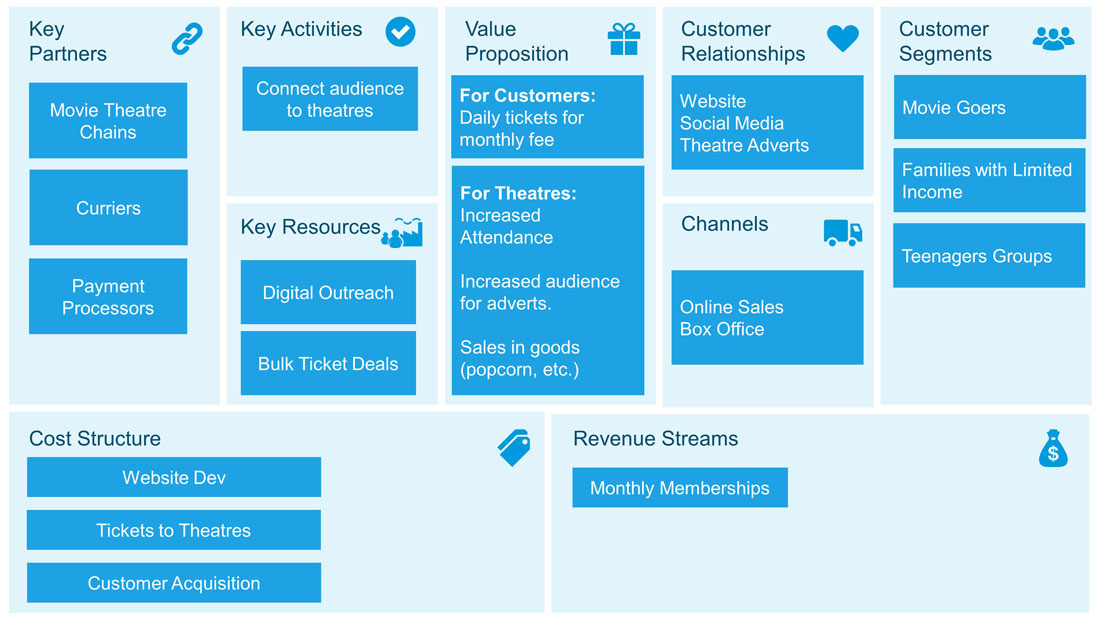
By using the BMC, MoviePass could have visualized earlier that the business model was in need of a pivot, a change to a section of the model in order to address an issue. In MoviePass’s case, areas like cash flow and customer acquisition had some gaps that required a solution. Had the company been more aware of its business model, it might have seen a need for a Minimum Viable Product (MVP) where they could test the results of their ideas with a few early adopters.
An MVP is the bare bones of a product or service that can provide invaluable information about how a small group of customers reacts. By having a testing period of limited engagement, a business can limit costs while drastically improving knowledge on how to proceed. Had MoviePass used this, they might’ve been able to observe early on that some customers used their service to the max, purchasing a movie ticket per day, far outweighing the profit of their service from the cost of providing it.
The pivot would adjust to their business model, and a new MVP could be created to test the new approach. This new iteration of the business may have changed the original direction of the company. Through each pivot and each new iteration of the model, MoviePass BMC would adjust accordingly, allowing an easy method in which to keep track of the major changes without getting overwhelmed in all the details that lay underneath each educated decision.
There are, however, examples of well-crafted business models that can be observed on a BMC. Let’s take a company that has spread its business model all over the world and has undoubtedly enacted countless pivots and iterations of the business model in order to evolve, adapt, and thrive over the years: McDonald’s, as one of the prime business model examples.
When thinking about the massive scope of McDonald’s, it’s both interesting and telling of how the BMC can still capture the essence of their business model. McDonald’s is a global corporate cash cow requiring a rock-solid model, but that doesn’t mean it’s the same one since the conception of the company.
With the many decades in operation, you can be sure that a McDonald’s BMC would not look the same at the beginning as it does today. What originally started as a single burger joint on a street corner, now faces the challenges of global food service. Each time a new challenge or opportunity presented itself, the McDonald’s business model was forced to pivot by observing the environment, developing an appropriate plan of action, and monitoring the progress accordingly.
Over the years the world has grown to experience many iterations of the McDonald’s brand, whether it be an icon of American cuisine or an example of adaptation to dietary health. Flexible and ambitious, McDonald’s always made sure the business model matched the desired outcomes.
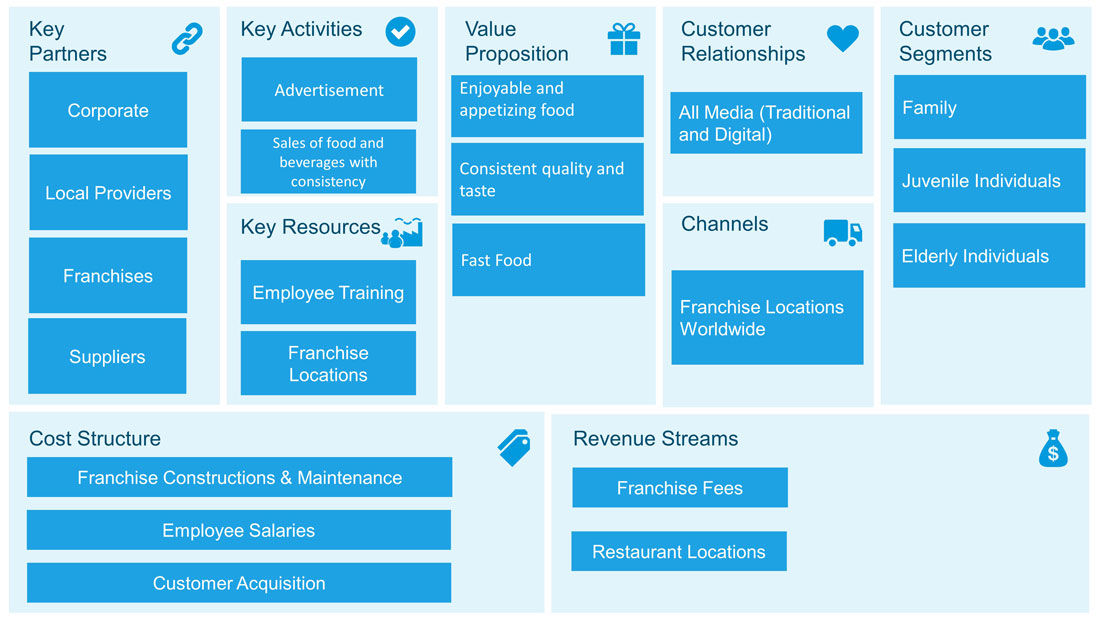
Uber is a ride-hailing service that has caused massive disruption for conventional taxi services. By using digital technology and a specific standard for cars and drivers offered to customers, many taxi services and individual taxi drivers have found it hard to compete with Uber. In contrast to developed countries, taxi drivers in developing countries have been unable to meet the minimum vehicle standards to qualify as Uber drivers, competing with them virtually out of the market. On the contrary, it has also attracted a new segment of people looking to use Uber as a part-time job to earn extra money.
By looking at Uber using the BMC Example we can see that its key partners include customers, drivers, payment processors, mapping data providers, and local authorities in the country it operates. Its key activities include developing its digital platform and algorithms, driver onboarding, marketing to balance demand and supply, and supporting customers using the service. The key resources of Uber are its digital platform, pricing, and routing algorithms. Uber relies on a peer-to-peer (P2P) circular economy. Where customers and drivers continue to contribute to the Uber revenue in almost a loop. And since Uber is easier to use compared to conventional taxi services, both customers and drivers tend to often use it as a routine. For example, many drivers have completely switched to Uber from conventional taxi services and new drivers entering the market cannot imagine providing services without the model Uber provides. Similarly, customers can get used to the service in a way that the Uber service itself becomes a part of their daily routine.
The value proposition of Uber is the provision of an on-demand taxi service for customers, whenever and wherever they need it. Uber fills the gap for the availability of an instant taxi service, without the need to necessarily ensure pre-booking or find a taxi manually. This offers user convenience, with various value benefits for both the customer and drivers, including the option to avail a cash-free taxi service by customers, earning opportunities for drivers and the supply of passengers and drivers through its ever-increasing base of users.
Uber reaches its customers and even attracts new drivers through its marketing and makes it easier for people to use its services through its app. Making it easy for the customers and drivers to communicate. Uber provides the utility of not just an on-demand service but also uses its algorithms to match supply and demand, find the shortest routes for customers, and to allocate the closest driver. However, since Uber is primarily connecting customers and drivers, it also shifts much of its costs to the former, since it does not require owning and maintaining a large fleet of cars. It can also adjust its revenue based on the market it’s operating in, and adjust prices to match not only demand and supply but the purchasing power and market rates of the country or area it operates in.
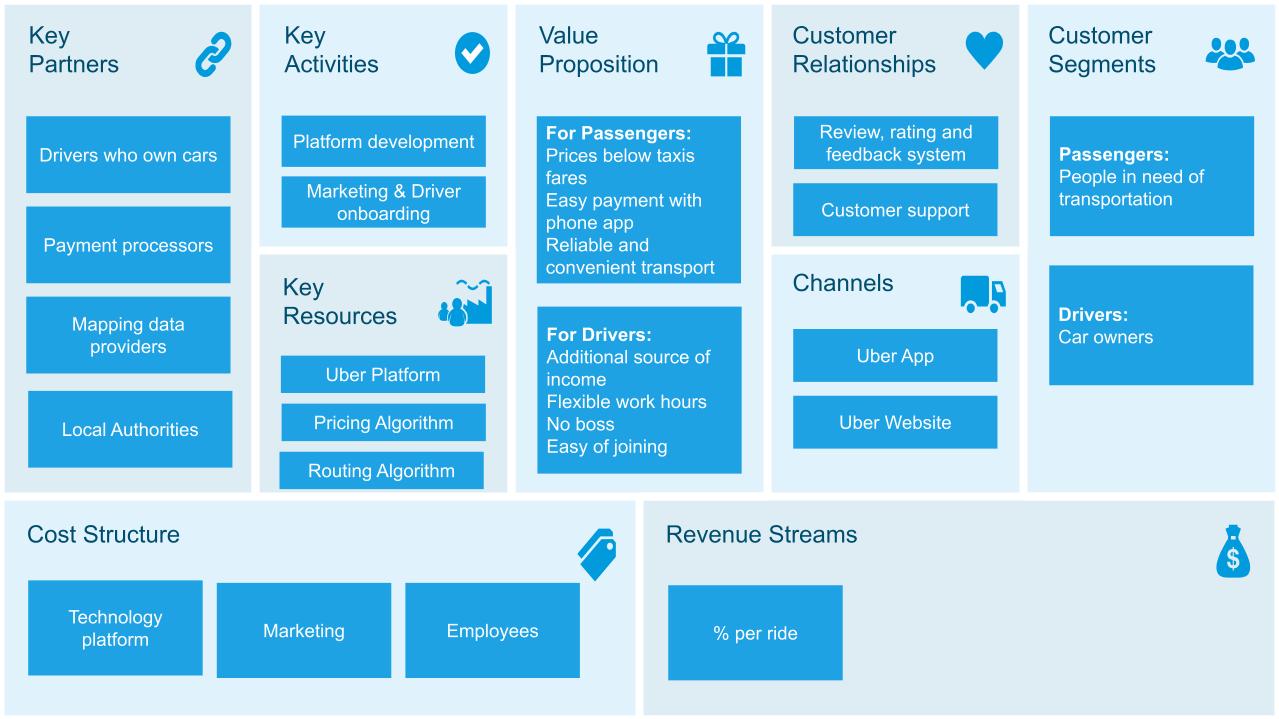
When Amazon started in 1994, terms like e-commerce or online shopping were virtually unheard of. In fact, Amazon can be easily credited with being one of the first e-commerce platforms in the world. However, its customer-led approach, with the convenience Amazon offered soon turned it into a famous retailer, which now has various other services attached to its name including an online video streaming platform called Amazon Prime, a cloud storage service (Amazon Drive), Kindle tablets, Fire TV, etc. However, to keep things simple, let’s look at Amazon’s BMC Example in the context of its retail store.
Amazon provides users with a range of services from its network of sellers. These sellers are rated by customers according to their experience and sellers that fail to adhere to Amazon’s standards are removed from the platform. For example, during the start of the COVID-19 pandemic, many people began hoarding hand sanitizers and selling them at inflated prices online. Amazon was quick to act to remove such vendors.
The approach that Amazon has is based on not just connecting buyers and sellers but ‘continually raising the bar of the customer experience’. To ensure this, amazon often takes innovative steps that not only include improving its digital platform but also ensuring a steady supplier base. In 2019, Amazon announced $10,000 and three months worth of their gross salary to employees who quit their jobs and started a delivery service. Anticipating the need to expand its supplier base. Amazon has also been famous for offering competitive employee benefits and creating a corporate culture that encourages innovation and employee loyalty.
Through its colossal warehouses, customer-centric approach, and corporate culture that creates an atmosphere of employees to remain closely connected with the company, Amazon’s revenue stream simply does not rely on its customer experience, workforce, or supplier base but on how it’s able to create an environment where stakeholders, including customers and employees feel a sense of loyalty towards the company.
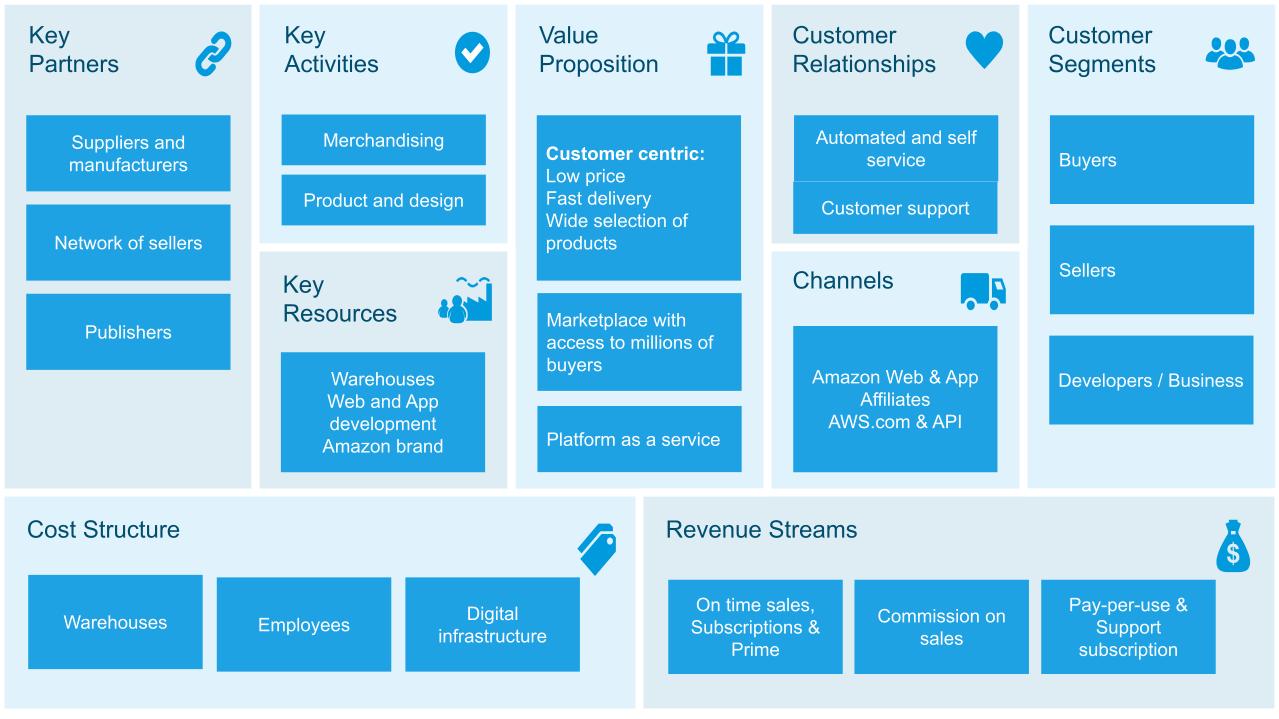
Over the years, AirBnb has been among companies that have leveraged their platform to transform conventional modes of doing business. Using its rating-based digital platform, AirBnb enables people looking to rent accommodation and hosts to be able to connect and become a part of its revenue stream with a few simple taps or clicks.
The platform has not only helped people who have conventionally been renting out their property but also enabled individuals with extra space to consider becoming hosts to earn extra money by renting out space for a short period of time. Similarly, the customers benefit from avoiding hefty rates of hotels and expensive accommodation options.
Like Uber, AirBnb has also been a disruptive force in the market it has operated. It uses its digital infrastructure to connect travelers and hosts. While offering the value proposition of making money by utilizing underutilized space to hosts and offering low-cost accommodation for people looking to save money. This model has enabled the company to surpass large hotel chains and make a major impact in the industry for rent and accommodation. In 2020 AirBnb was valued at $75 billion, surpassing giants like Hyatt Hotels valued at $2.07 billion and Marriott Hotels International valued at $10.57 billion.
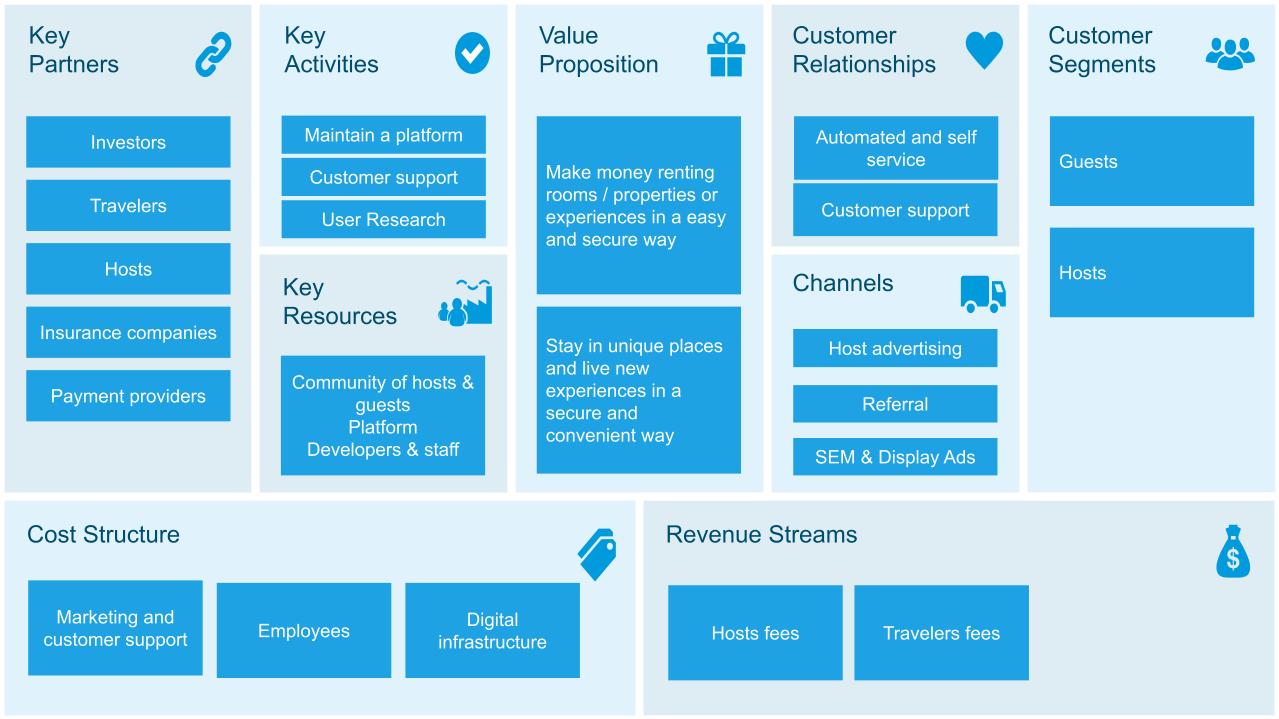
From its launch in 1997 to 2006 in the United States, Netflix had a per-rental model per DVD. However, in 2007 it launched a subscription-based model that turned out to be more successful. Today, Netflix is available for streaming in over 190 countries, each with its own catalog of Movies and TV shows.
According to Netflix’s Business Model Canvas Example, its value proposition is the provision of on-demand entertainment regardless of where you are. Its subscription models provide access to one or more screens, with the utility to watch Netflix via mobile, tablet, laptop, gaming consoles, etc. Its packages include an economical package with an SD (480P) resolution limited to a single device to more exclusive packages offering Full HD (1080p) Ultra HD (4K) and HDR (2160p) resolutions.
Needless to say, the market segment of Netflix is quite close to universal. Outmaneuvering cable operators and conventional TV channels with exclusive on-demand content. While Netflix’s partners have included broadcasters and production companies, it has recently been focusing on original content. Through Netflix’s subscription-based model, there is very little need (if any) for customer interaction, unless a user is reporting a bug. The Netflix model focuses on self-service with an ‘all you can eat’ style subscription model, with algorithms constantly suggesting content to users to keep them engaged based on their viewing preferences.
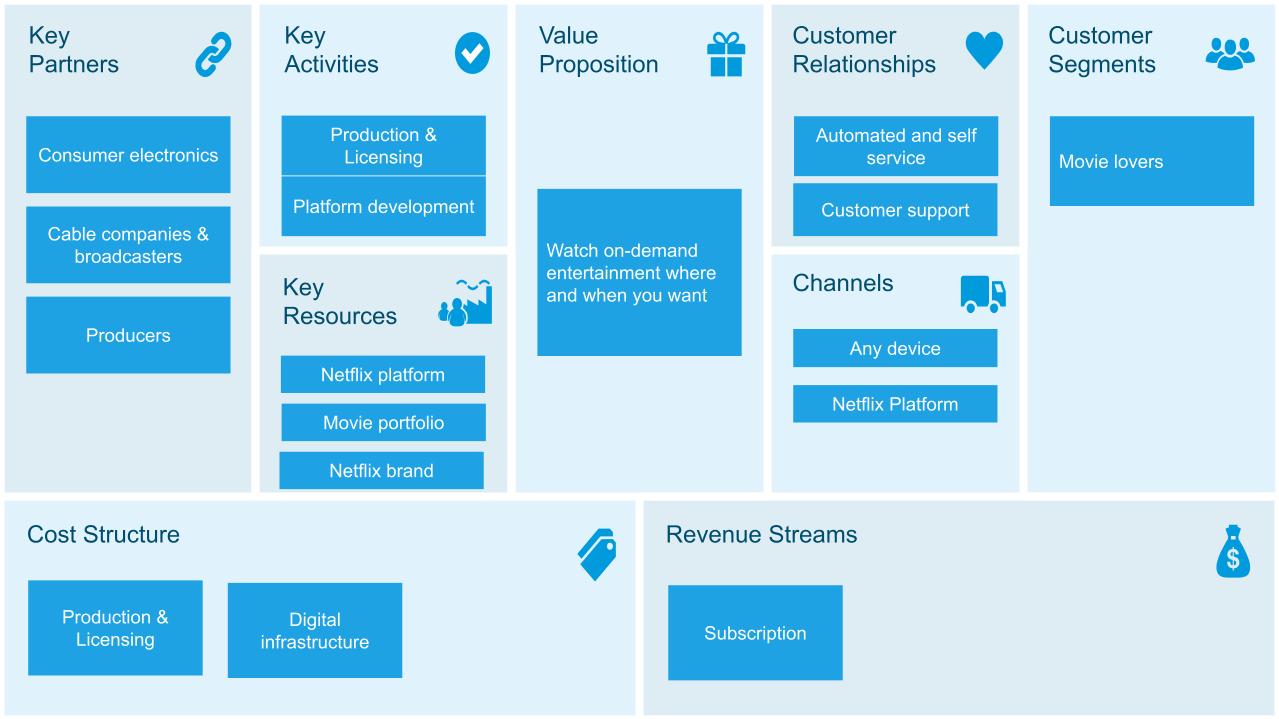
Ikea’s value proposition is to provide affordable furniture that is sturdy, aesthetic, and functional enough to cater to customer needs. In doing so Ikea claims to create a better everyday life for people who use its products. The Business Model Canvas Example of Ikea includes its vendors, suppliers, franchisees, and logistics partners making it possible to reach out to customers globally.
Unlike companies like Amazon, e-commerce is only part of Ikea’s operations, as it has a robust physical presence in more than 50 countries. Over the years Ikea has undergone continuous product development with new furniture designs and a range of products being released on a consistent basis. This has helped the company to cater to the needs of different customer segments including families, businesses, and people who need something that is easy to use, assemble, and disassemble.

How to Utilize a Business Model Canvas for Your Success
Whether it be a brand-new business endeavor or a product launch at a long-standing company, it’s critical that the business model is kept at the core of every decision. A Free Business Model Canvas Template is a tool to easily keep the model insight and offers an easy method to open the dialogue when that model may need to pivot.
The whole purpose of the BMC is to allow for a simple presentation of information, reducing complications in understanding just what is required in each new iteration of a business model. At a glance, anyone invested in the outcome of the model should be able to understand the who, what, when, where, and why of the model, or bring it to everyone’s attention if they don’t.
Most importantly, the BMC is a tool to help drive success. If there are issues in your business model that need to be addressed, a BMC makes it easier to visualize where the gaps are, and how they may be filled. Keep in mind that pivoting is crucial to the success and survival of a business model and that change, growth, and adaptation are not an abandonment of what matters, but a natural progression to find the best outcomes to the ultimate goal. As Eric Ries, author of Startup Lessons Learned, puts it: ‘pivoting may lead [successful startups] far afield from their original vision, but if you look carefully, you’ll be able to detect common threads that link each iteration.’
Frequently Asked Questions
Business Model Canvas is like a blueprint for your business. It’s a visual tool that helps you plan, understand, and describe how your business works. It breaks down your business into key parts, like who your customers are, what you offer them, and how you make money.
A real-life example would be Airbnb. They use the Business Model Canvas to show how they connect hosts with travelers, offer unique accommodations, and earn money through commissions on bookings.
To determine your value proposition , you need to identify what makes your product or service special. Ask yourself: What problem does it solve for customers? What benefits do they get? Your value proposition should clearly communicate these advantages.
Building and maintaining customer relationships involves providing excellent customer service, staying engaged with customers through various channels (email, social media), seeking feedback, and addressing their needs promptly.
When establishing partnerships, consider what resources or expertise your business lacks and seek partners who can provide them. Think about how these partnerships will benefit both parties and align with your overall business goals.
The Business Model Canvas allows you to see all aspects of your business in one place, making it easier to identify weaknesses and opportunities. By analyzing each component, you can make informed decisions to optimize your model for better results.
Yes, the Business Model Canvas is versatile and can be used for various businesses, from startups to established companies, in different industries. It helps structure and clarify the business model for any venture.
The frequency of updates depends on your business and market dynamics. In rapidly changing industries, you might need more frequent updates, while others may do so annually or when major changes occur.
Use your Business Model Canvas as a visual aid during presentations. Walk stakeholders through each section, explaining how your business operates and creates value. Encourage questions and discussions to ensure clarity and alignment.
If you want to create professional-looking Business Model Presentations, take a look at the following Business Model Canvas templates , ready to edit and easy to use.
1. Free Business Model Canvas Template for PowerPoint
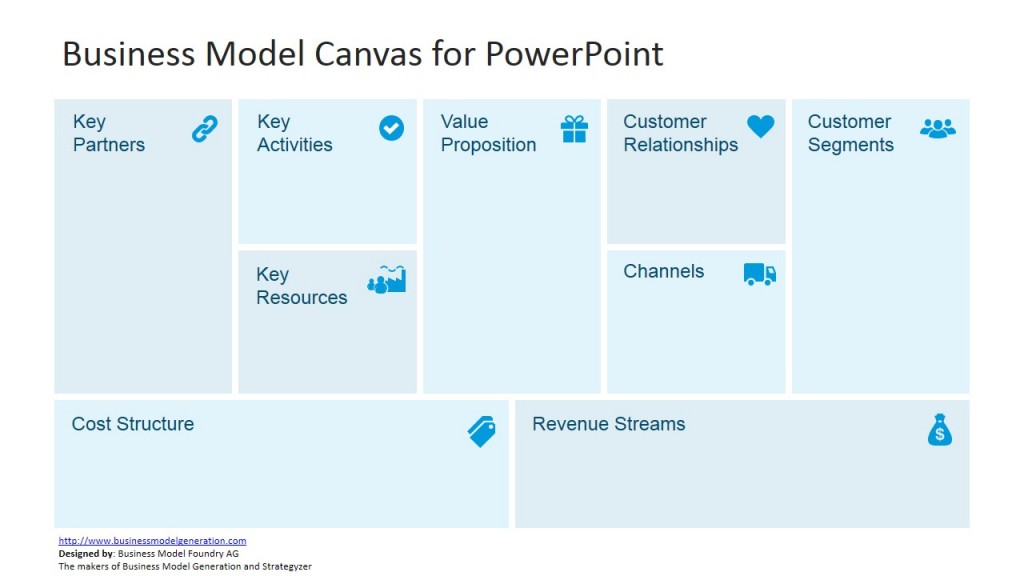
Build a top-notch company presentation using Free Business Model Canvas Template for PowerPoint. The cool scheme is relaxing to the eyes. The clear layout can provide the audience with quick understanding of the entire report in just one slide.
Use This Template
2. Animated 3D Business Model Canvas Template for PowerPoint
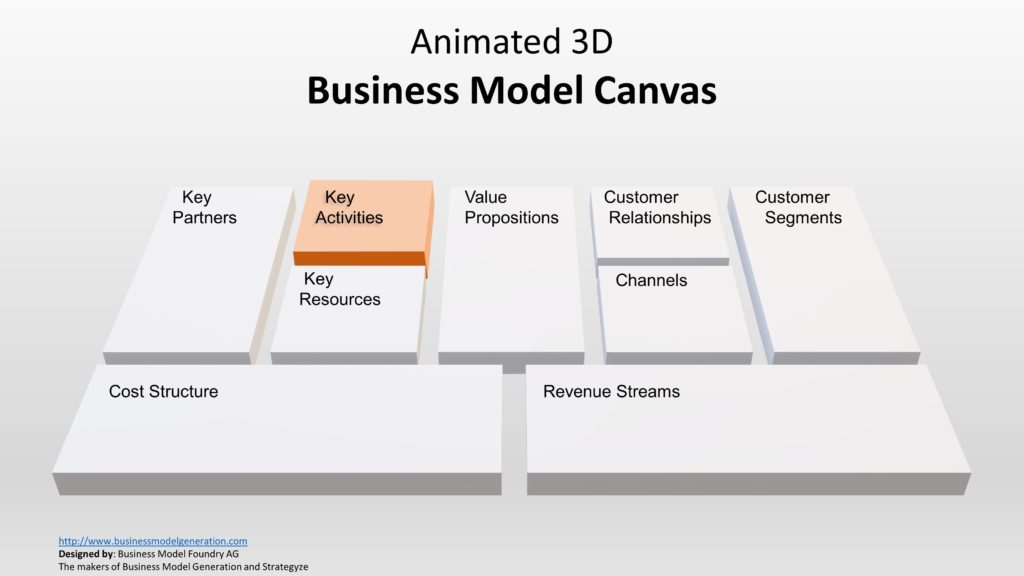
Created with a 3D Model, this professional PowerPoint Template is ideal for creating videos or animated versions of your Business Model Canvas. Very popular among educators and speakers of the entrepreneurship niche.
3. Business Model Canvas PowerPoint Templates

This Business Model Canvas PowerPoint Template is created 100% with editable PowerPoint Shapes, allowing the user to customize the content and visual appearance of the presentation. Suitable for educational presentations where you need to navigate each section of the BMC, or for investors presentations where you need to deep dive on each section of your Business Model.
4. Business Model Canvas Template for PowerPoint
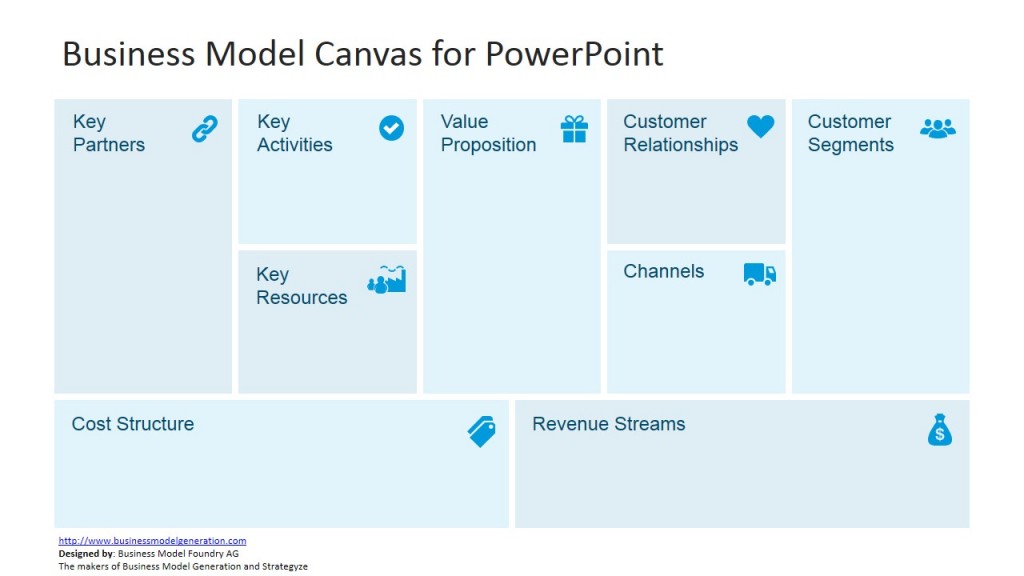
Our most popular Business Model Canvas Template. Ideal for working in groups and iterating with different BMC’s. Its suitable for cooperation editing, and allows very simple compositions. Well suited for developing your MVP and crossing the assumptions that were negated by reality.
5. 3D Perspective Business Model Canvas PowerPoint Template
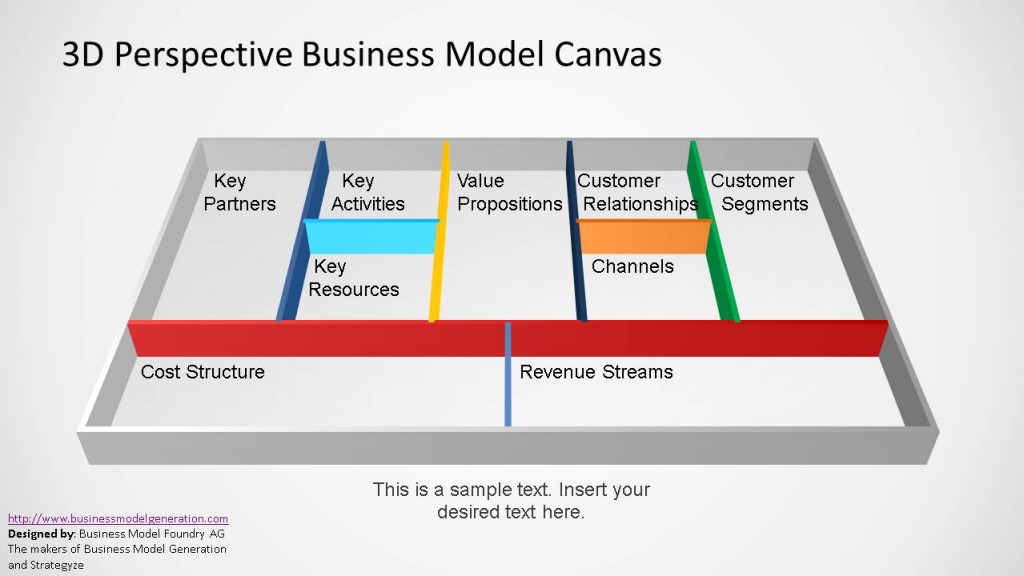
This Business Model Canvas Design is inspired in the idea of empty boxes, that entrepreneurs need to fill with their ideas. The design is simple to edit and decorated with a colorful theme. Designed to impress every audience.
6. Lean Canvas PowerPoint Template

This Lean Canvas template for PowerPoint and Google Slides is perfect for anyone who needs to pitch a business idea to investors, present their idea to stakeholders or company leadership. This template is 100% editable, allowing the user to customize the content and visual appearance.
7. Product Management Canvas PowerPoint Template
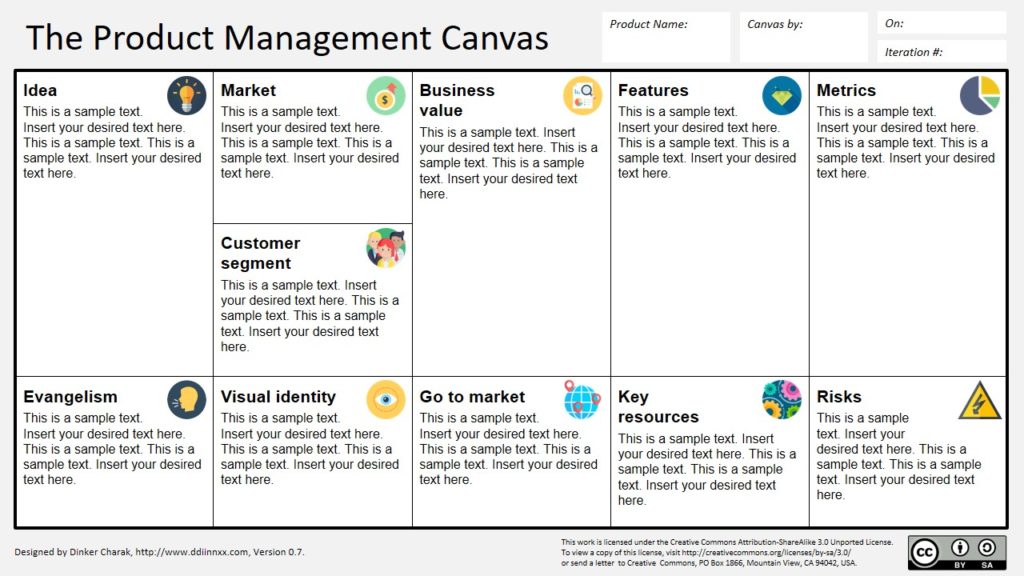
The Product Management Canvas PowerPoint Template is a strategic planning and modeling presentation. This is a single-slide template showing various aspects of product planning and successful management. The purpose of this canvas is to consider all aspects of the product.
8. Editable Business Model Canvas PowerPoint Template
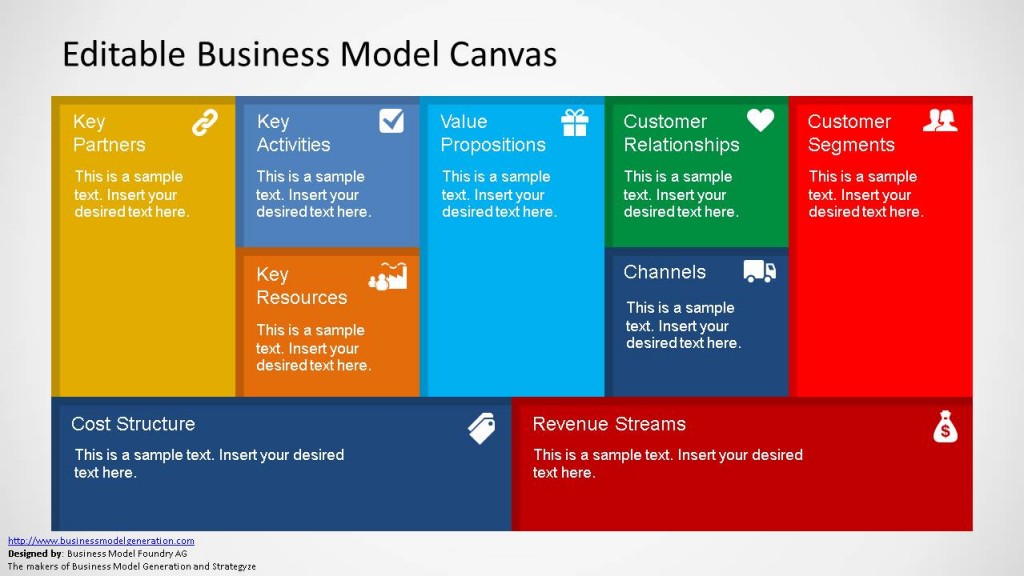
Editable Business Model Canvas PowerPoint Template is a professional presentation representing the Business Model Canvas in “board” format. All the presentation design is completely editable and the user can move, or add, post-its like text boxes to work with the canvas.
9. Simple Business Model Canvas Template for PowerPoint
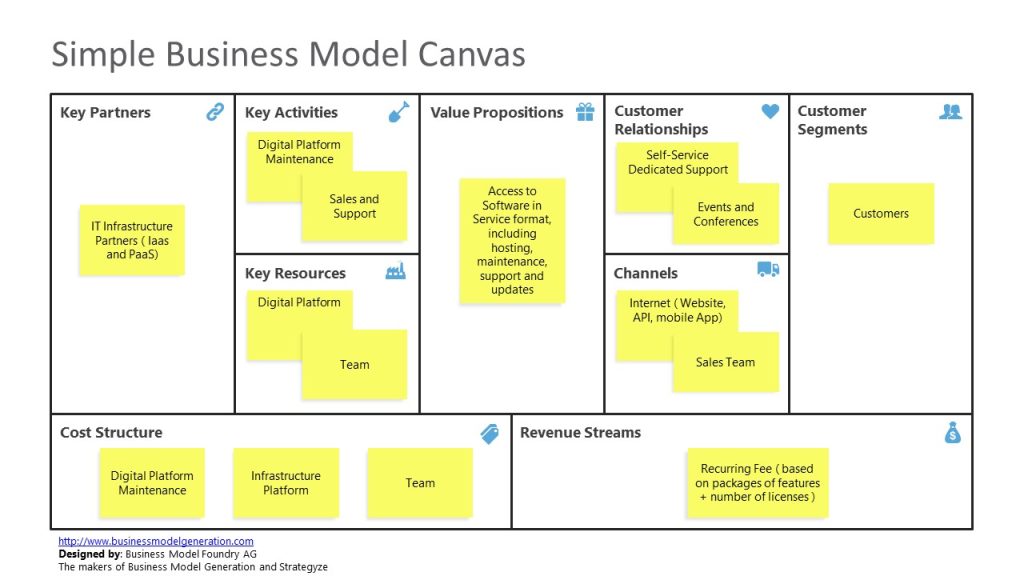
If you are looking to create an aesthetic Business Model Canvas Template, the Simple Business Model Canvas Template for PowerPoint will allow you to give your presentation the style you need. You will be able to add sticky notes with information for each of the sections of your Business Model.
10. Business Model Canvas Template with Widget Design
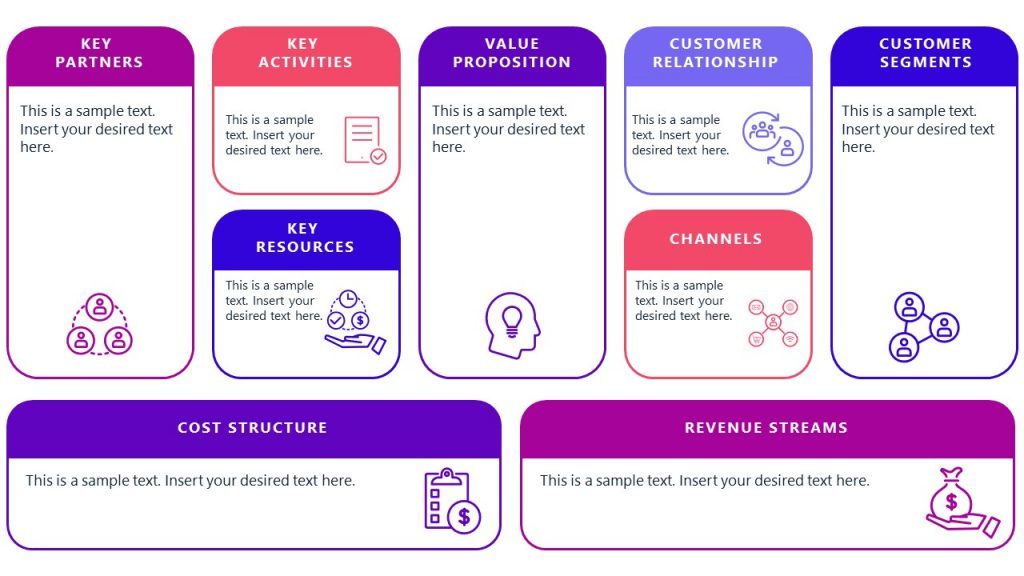
100% editable Business Model Canvas template for Google Slides and PowerPoint presentations, with a widget design and look and feel.
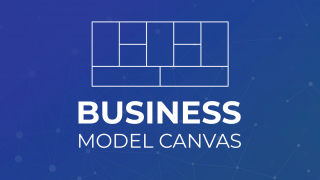
Like this article? Please share
Acquisition, Business Model Canvas, Channels, Cost Structure, Customer Development, Customer Relationship, Customer Segments, Key Activities, Key Partners, Key Resources, Lean Startup, Management, Minimum Viable Product, MVP, Prototyping, Revenue Streams, Startup, Steve Blank, Strategy, Value Proposition Filed under Business
Related Articles

Filed under Business • January 31st, 2024
How to Create a Sponsorship Deck (Guide + Examples)
Impress your audience and secure deals by knowing the insights on how to create a winning Sponsorship Deck. Step-by-step instructions + templates.
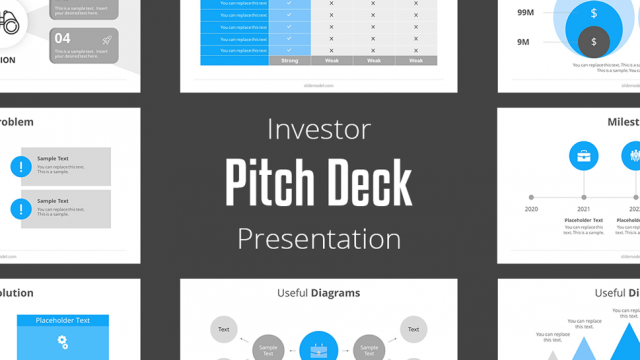
Filed under PowerPoint Tutorials • January 7th, 2024
How to Create a Great Investor Pitch Deck Presentation and Close the Deal
If you’re a start-up, then you probably already heard the term pitch deck presentation. A pitch deck presentation is a presentation and it’s intended to showcase your company’s product, opportunity, team to potential investors. Pitch decks are your company’s elevator pitch in a presentation. You are often used to help convince investors to raise capital. […]

Filed under PowerPoint Tutorials • November 8th, 2023
How To Present an Action Plan
An Action Plan is a sequence of steps that must be performed for a strategy to succeed. Learn how to present your Action plan to an Executive Audience.
2 Responses to “What is a Business Model Canvas? Quick Guide + Examples”
If your business is a non-for-profit , how can you adapt your MVP? You are not selling anything as such, so how do you test if your product (MVP) will be purchased?
Hi Elena If there is a “business model”, there is always a business. So, you are selling something. Even non-for-profit sell. They just sell at “cost” or “subsidized”, but there are customers which pay at the end. Otherwise, rather non-for-profit, it is philanthropy and there is no “business” around. Hope this helps. Regards GV.
Leave a Reply
- Integrations
- Learning Center
How to Build a Product Roadmap Based on a Business Model Canvas
Could you list all of the key building blocks you need to develop, manage, maintain, market, and sell a product on a single sheet of paper? With the business model canvas, you can! Using the business model canvas approach is a great way to force yourself to focus on the most strategically important elements of your product. As the name suggests, the typical use case for this tool is to outline the fundamental building blocks of a business, but it also can work really well for a product.
Today we’ll show you how the business model canvas works and how you can use it to come up with a high-level product strategy.
What is a Business Model Canvas?
As you can see from the sample example below (thanks, Strategyzer.com), a business model canvas is a one-page summary describing the high-level strategic details needed to get a business (or product) successfully to market.
The categories or buckets contained in a canvas can be customized. But most will look similar to the one here—covering such key areas as:
- The product’s value propositions (what it does and promises)
- Customer segments (who it’s for)
- Key activities (the steps the team must complete to make it successful)
- Key resources (what personnel, tools, and budget the team will have access to)
- Channels (how the organization will market and sell it)
- Customer relationships (how the team will support and work with its customer base)
- Key partners (how third parties will fit into the plan)
- Cost structure (what it costs to build the product as well as how to sell and support it)
- Revenue streams (how the product will make money)
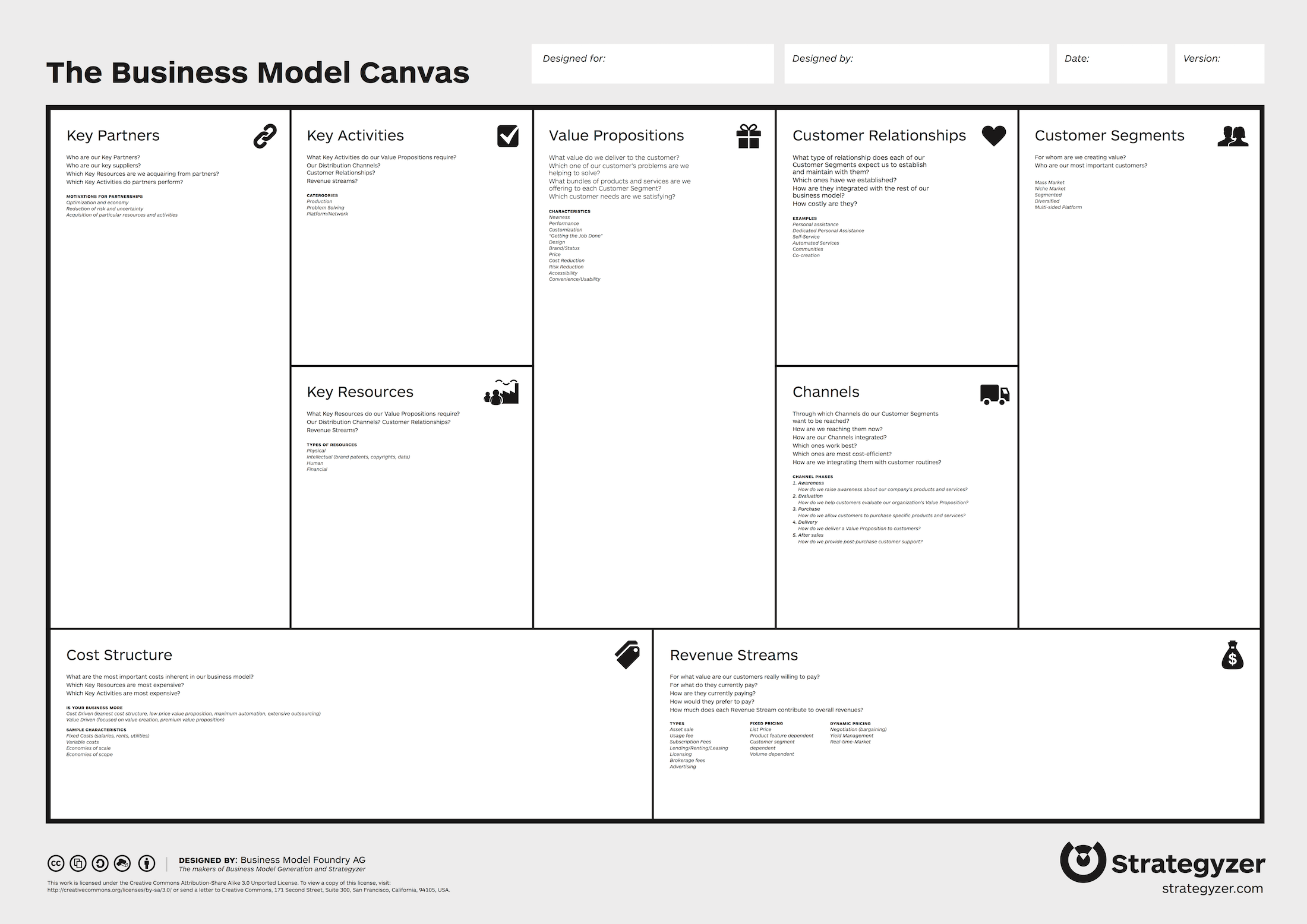
If you think about it, that’s a fairly comprehensive set of building blocks you’ll need to think through for your product before you begin developing it. There will certainly be additional factors that’ll affect your strategy, but if you can fill in these high-level details—which, as you can see, should fit comfortably on a single page—you’ll have a useful strategic guide for developing your product roadmap.
Why Should I Use a Business Model Canvas to Develop a Product Roadmap?
Okay, but why? What’s the benefit of building a business model canvas (or the, even more, stripped-down variation, the lean canvas) to guide my product roadmap ?
There are plenty of reasons. But simply put, you can think of a business model canvas as a mission statement for your product roadmap. It’s a handy reference you can refer to, to make sure your roadmap always reflects all the strategic elements needed for your product’s success.
Tweet This: “Think of a business model canvas as a mission statement for your product roadmap.”
Our co-founder Jim Semick has a couple of great short videos explaining the business model canvas concept, which you can check out in the player below.
As Jim explains, here are a few of the benefits of using a business model canvas to think through product strategies:
1. You can use a business model canvas to roadmap quickly.
You can use this canvas approach in just a few hours (and as Jim says, you can even do it with sticky-notes).
This way, rather than trying to write out every detail about your product plan beforehand, you can just document the highlights—and then you can get rolling translating the canvas into your product roadmap.

2. A business model canvas will be more agile.
One problem with the old structure of documenting a business model—the traditional business plan—was that it was almost always inaccurate as soon as the author finished drafting it.
These meaty plans included detailed cost estimates, revenue projections going years into the future, and long-term plans for growing the staff. How could any of that remain accurate for long?
In product terms, you can think of the business plan as resembling an MRD (Market Requirements Document). It’s long, detailed, and probably mostly untrue by the time it’s done.
But because you can put a canvas together so quickly, it will much more accurately reflect your strategic thinking and your company’s current reality. And if things change, it’ll be easier than a long and detailed plan to adjust. This brings us to Jim’s third benefit…
3. Business model canvas roadmaps allow you to pivot as needed.
If you build a business model canvas to guide your business roadmap , and something happens that forces you to re-prioritize or pivot your product , it will be a lot easier to update this short, high-level document than it would be if you had some monster MRD or business plan to tear apart and edit.
With a one-page business model canvas acting as the strategic undergirding for your roadmap, you’ll always be able to quickly spot any items or plans that need updating whenever priorities change or new realities demand that you adjust your approach.
How Can I Use A Business Model Canvas to Guide My Product Roadmap?
The alexa example.
Let’s talk through a hypothetical example, using Amazon’s Echo device (“Alexa”) as our guide.
Imagine that as they were talking through what belonged in the “Revenue Streams” bucket of the business model canvas, Amazon’s Echo team came up with three sources of revenue to start with:
1) Selling Echo devices.
2) Using the device to sell other stuff as customers ask it to connect to the Amazon marketplace. (“Alexa, please add laundry detergent pods to my shopping cart.”)
3) Licensing Echo’s proprietary speech-recognition technology to other businesses.
Now, if the Echo product team put these on their business model canvas, they’d know that they need to make room for budget, time, and resources on their product roadmap for all of these revenue streams.
Another Hypothetical Example of the Business Model Canvas: Channels
Or think about the Channels bucket in the business model canvas. If your team was building out a canvas, maybe you’d have several ideas for reaching customers:
1) The in-house sales team. 2) Affiliate partners. 3) Word-of-mouth advertising from users.
It’s easy to write. But how are you going to translate that “word-of-mouth” strategy into an actual plan?
Maybe you’ll need to budget time and resources for developing things right into your product that make it easier for users to share their experiences with friends, such as a handy tool to help them tweet about it. Maybe you’ll even want to include an “Invite a friend” feature that lets users easier send a trial license to friends, or a couponing feature that offers some reward to a user who brings in two more users.
The point is, your business model canvas can serve as a great strategic reminder of the things you’ve determined are important enough to make it onto your product roadmap .
So you can always look back and see immediately—it’s just one page, after all—if you’re still working on all of the essential elements of your product, or if you’ve inadvertently strayed from them and gotten lost in the wrong details.
That’s why we’re big proponents of the business model canvas approach to guiding your product roadmap .
Do you have an opinion about using the business model canvas approach for developing and documenting your product’s strategy? Feel free to share them in the comments section.

Product Management Training: 5 Excellent Resources
If you want to become a software developer, one option is to major in computer science or software engineering in...
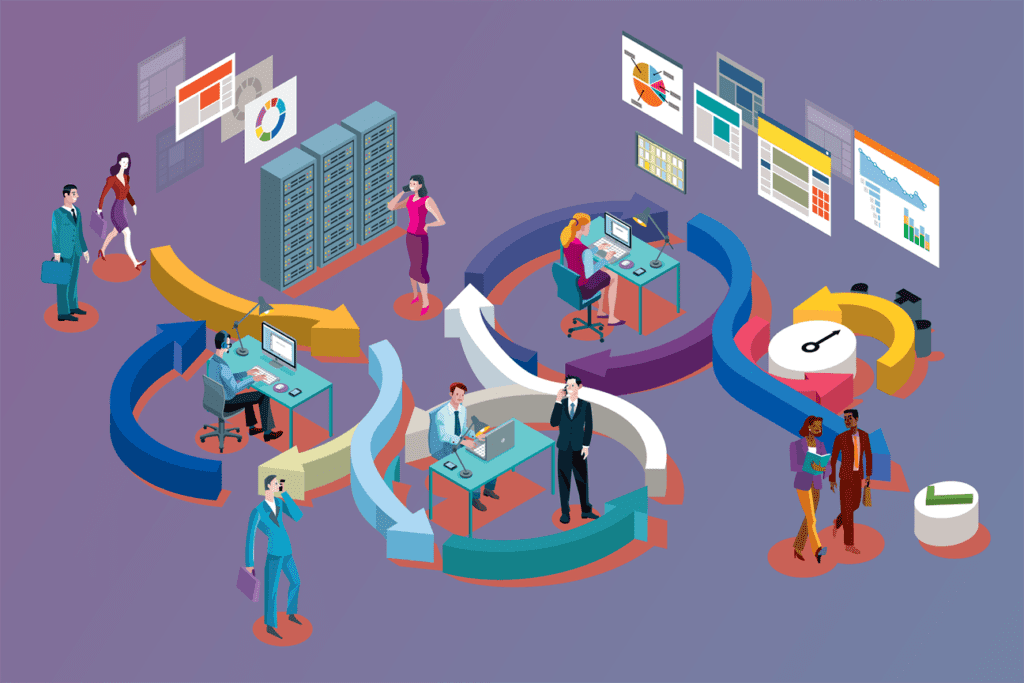
A Product Manager’s Role in SAFe®
Agile started with software development. Although many organizations have found the principles beneficial. The ability to quickly assess, adjust, and...
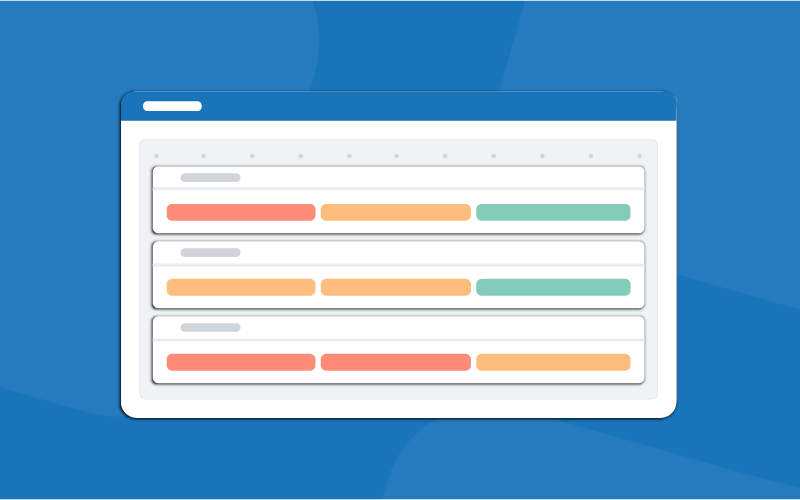
5 Roadmap Templates for Product Executives
Product roadmaps shouldn’t be a one-size-fits-all proposition, as different stakeholders care about various elements and require different levels of detail....
Continue exploring
You can search or explore specific categories.
Prioritization and Backlog
Company news and updates, templates and workbooks, remote product management, product metrics and analytics, product strategy example, product managers, tools and resources, customer-centricity, product leadership, product management, roadmap and roadmap management, product strategy, agile & product development, career and interviews, try productplan free for 14 days, share on mastodon.

Online Plagiarism Checker for Academic Assignments
Start Plagiarism Check
Editing & Proofreading for your Academic Assignments
Get it proofread now
Free Express Delivery to All Places in Canada
Configure binding now
- Academic essay overview
- The writing process
- Structuring academic essays
- Types of academic essays
- Academic writing overview
- Sentence structure
- Academic writing process
- Improving your academic writing
- Titles and headings
- APA style overview
- APA citation & referencing
- APA structure & sections
- Citation & referencing
- Structure and sections
- APA examples overview
- Commonly used citations
- Other examples
- British English vs. American English
- Chicago style overview
- Chicago citation & referencing
- Chicago structure & sections
- Chicago style examples
- Citing sources overview
- Citation format
- Citation examples
- College essay overview
- Application
- How to write a college essay
- Types of college essays
- Commonly confused words
- Definitions
- Dissertation overview
- Dissertation structure & sections
- Dissertation writing process
- Graduate school overview
- Application & admission
- Study abroad
- Harvard referencing overview
- Language rules overview
- Grammatical rules & structures
- Parts of speech
- Punctuation
- Methodology overview
- Analyzing data
- Experiments
- Observations
- Inductive vs. Deductive
- Qualitative vs. Quantitative
- Types of validity
- Types of reliability
- Sampling methods
- Theories & Concepts
- Types of research studies
- Types of variables
- MLA style overview
- MLA examples
- MLA citation & referencing
- MLA structure & sections
- Plagiarism overview
- Plagiarism checker
- Types of plagiarism
- Printing production overview
- Research bias overview
- Types of research bias
- Research paper structure & sections
- Types of research papers
- Research process overview
- Problem statement
- Research proposal
- Research topic
- Statistics overview
- Levels of measurment
- Measures of central tendency
- Measures of variability
- Hypothesis testing
- Parameters & test statistics
- Types of distributions
- Correlation
- Effect size
- Hypothesis testing assumptions
- Types of ANOVAs
- Types of chi-square
- Statistical data
- Statistical models
- Spelling mistakes
- Tips overview
- Academic writing tips
- Dissertation tips
- Sources tips
- Working with sources overview
- Evaluating sources
- Finding sources
- Including sources
- Types of sources
Business Model Canvas – Key Components Explained
How do you like this article cancel reply.
Save my name, email, and website in this browser for the next time I comment.

Starting a business from scratch requires a lot of work and planning. The amount of preparation put into the process significantly influences its success. For this reason, a Business Model Canvas is important. In this article, we will be looking at the details of this specific business conceptualization, and why it is indispensable in an entrepreneur context. Finally, we’ll talk about how you can create one and provide two filled-out models as examples.
Inhaltsverzeichnis
- 1 In a Nutshell
- 2 Business Model Canvas Definition
- 3 Internal Components of a Business Model Canvas
- 4 External Components of a Business Model Canvas
- 5 Creating Your Own Business Model Canvas
- 6 Business Model Canvas Template
- 7 Business Model Canvas FAQs
In a Nutshell
A business model canvas is a tool for strategic management and entrepreneurship. It is an important tool for planning a business model. It is made up of two essential business components (internal and external) which are further split into subsections. These sections make the business model easy to understand so that you can begin developing your business.
Business Model Canvas Definition
A business model canvas is a management and entrepreneurial tool. The business model canvas is made up of a description, design, challenge, invention and the pivot of your business model. In simpler terms, it is a plan that describes how your business plans on making money whilst continuously growing, including all the components that are important to the process.
Internal Components of a Business Model Canvas
There are two types of components contained in a business model canvas- internal and external business components. The internal ones are made up of the elements within the business that significantly affect its success. They are on the left side of the business model canvas, with value propositions in the middle. They include;

Key Partners
These are the people or businesses that are going to assist you with your business. Note that you personally cannot handle every aspect of your business. Therefore, you may need some assistance from different parties here and there. Examples of key partners are suppliers and buyers. When determining the key partners, you need to figure out what you need from them. You may not need to form partnerships at the start of your business. However, the more your business grows, the more the need for partners.

Key Activities
These are the most important things that you must handle to make your business model efficient. They are mandatory activities that you need to be professionals at for you and your business to become successful. For instance, if you are a manufacturing company, your key activity is manufacturing products. Your business can include more than one key activity depending on the type of business.

Key Resources
This section consists of all the resources you need for your business to succeed. The resources may include raw materials, labor, and financial resources. The component must include every resource without which the business would fail. Make sure to split them into the most important ones, how and where you will get them.

Cost Structure
The cost structure consists of the amount of money you need to keep your business alive. Here, there are several factors to consider. They include the cost of getting materials, manufacturing the products, labor, rent, electricity, equipment and machinery, as well transportation. You have to make sure that you factor in all the costs. You have to split them into the most essential ones and the most expensive ones. You also want to consider the cost of the key partnerships and other every activity. You will also need to perform some accounting tasks and answer some vital questions about the economies of scale, fixed and variable costs. Just make sure you include everything that will cost you money in this section.
External Components of a Business Model Canvas
The external components of a business model canvas are made up of the external features that will influence the success of your business. They are typically on the right side of a business model canvas. They include;

Customer Relationships
In this segment, you discuss how your business intends on getting customers. How you will know your customers and grow them. The customer relationships depend on the customer segments and the channels you intend on using. For instance, if you are using a website, you have to figure out how you will get clients to visit the website.

Customer Segments
This is one of the most important components. You have to know the people clients you are catering to for your business to become successful. Here, you figure out who you want to sell to and what would drive them to purchase from you. Therefore, you have to figure out the specifics like where the clients live, their social habits, age, and gender among other details. This information is open to changes after testing and selling your product.

This component is made up of what you use to deliver the products from your business to the computer. Therefore, you have to decide which outlets are ideal for your business. Traditionally, this component would be made up of physical channels only. However, currently, you can have both physical and internet or mobile channels since your business needs to have a web presence.

Revenue Streams
Revenue streams refer to how you will make money from your value proposition (what you’re offering your customers and how it’s different from your competitors). You have to ask yourself questions like what is the value for which your clients are paying? How do you intend on capturing the said value? It could be through direct sales, freemium, subscription or licensing models. It all depends on the kind of business. Some businesses apply more than one revenue model. The revenue model greatly determines the amount of money you make.
Creating Your Own Business Model Canvas
When creating your business model canvas, you have to start by collecting the following items;
- A template for your business model canvas
- The writing utensils
- Post-it notes
- A white board or a book for business model generation (these two are optional)
Below is a step by step guide for creating your own business model canvas;
- Create a canvas with the different internal and external segments mentioned above. Make sure you have a large surface to incorporate all the information.
- After creating the writing surface, the first thing you need to do is figure out who your customers are going to be and their demographics. Fill in the information on the customer segment section.
- From there, you can proceed to the value section. Here, reflect on the value you wish to deliver to your clients through your business and how you will achieve it. Include information like customization, uniqueness, performance and how you plan to achieve them.
- The next section is the channels. Fill in information on how you intend to get your product to your customers.
- Proceed to the customer relations segment. Here, include information on the type of relationship you want to have with your customers, how you plan on making it a reality and maintaining it.
- From there, fill in the revenue streams segment. Here, consider how your customers will react to your value propositions. Consider all aspects of how you intend on making money.
- Then you have to fill in the key resources segment. Include all the resources your business will require to succeed.
- After the resources segment, go to the key activities segment. This segment is made up of what your business needs to do with the key resources.
- Proceed to the key partnerships portion. Here, discuss the strategic alliances, joint ventures, competition, and suppliers.
- Finally, complete the cost structure section. It is made up of all potential expenses.
Business Model Canvas Template
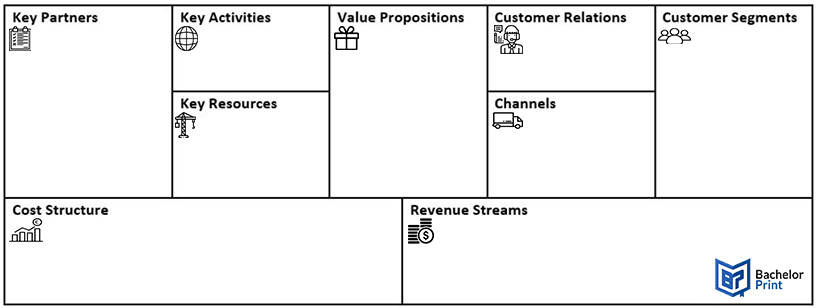
Business Model Canvas FAQs
Why is a business model canvas important.
A business model canvas is important because it helps you gain an in-depth understanding of your business. A business model canvas is made up of a wide range of segments that are central to your business. By strategically digging into each of the segments, you can tell which areas need improvement and visualize a clear path on which you need to build your business.
How do you create a business model canvas?
Creating a business model canvas doesn’t have to be difficult. You need to reflect keenly on your business and find out all the important details. Such details include; the key partners, activities, value proportions, customer relationships, customer segments, key resources, channels, cost structures and revenue streams.
What are the key activities in a business model canvas?
The main key activities in a business model canvas depend on the type of business. They consist of everything that your business does with resources (money, labor and raw materials among others). Examples of key activities include production, problem solving and the network of maintaining the key resources.
What are the value propositions in a business model canvas?
The value propositions are typically in the middle of a business model canvas. It includes the products or services your business will offer it’s customers and how it differs from your competitors. Example value propositions could be; price, efficiency, fancy packaging etc.
Is a business plan or a business model canvas better?
In a business model canvas, your business model is on paper and visualized with the external and internal environments split into subsections. A business plan on the other hand often stems from the financing plan. Both are necessary for starting a new business.
We use cookies on our website. Some of them are essential, while others help us to improve this website and your experience.
- External Media
Individual Privacy Preferences
Cookie Details Privacy Policy Imprint
Here you will find an overview of all cookies used. You can give your consent to whole categories or display further information and select certain cookies.
Accept all Save
Essential cookies enable basic functions and are necessary for the proper function of the website.
Show Cookie Information Hide Cookie Information
Statistics cookies collect information anonymously. This information helps us to understand how our visitors use our website.
Content from video platforms and social media platforms is blocked by default. If External Media cookies are accepted, access to those contents no longer requires manual consent.
Privacy Policy Imprint

IMAGES
VIDEO
COMMENTS
The Business Model Canvas (BMC) can be defined as a tool that is used in the generation of a business model. “The BMC is made up of nine building blocks forming a chart that describes a firms value proposition, infrastructure, customers, finances, resources, channels, revenue streams and cost structure” (Shaw 2011). We will write a custom ...
Here’s a step-by-step guide on how to create a business canvas model. Step 1: Gather your team and the required material Bring a team or a group of people from your company together to collaborate. It is better to bring in a diverse group to cover all aspects.
Download a PDF Business Model Canvas template, and take several colored markers, sticky notes, and anything else you may need. For example, if you are brainstorming in a big team, a board is a must for enhanced convenience. Online. Choose the platform where you will work with a template. It can be Google Docs, Omnigraffle, or the Stratygizer ...
The business model describes in concrete terms how an organization creates value, delivers it and how it makes money from this. There are 9 blocks that the Business Model Canvas consists of: Business Model Canvas. Here, the left part of the canvas focuses on efficiency and the right part on value: We are now going to cover the 9 different ...
Business Model Canvas. A business model adds more detail to the evaluation of a new business begun during the feasibility analysis by graphically depicting the moving parts of the business and ensuring that they are all working together. Lancelott gutierrezcampbell 2017 the purpose of business model canvas consists and describing the success ...
Quick Guide + Examples. Based on the work of Alexander Osterwalder, a Business Model Canvas, or BMC for short, is a diagram used to visualize a business model; it allows structured organization and a quick method of evaluation and reflection on the effectiveness of a Business Model. The use and study of Business Model Canvas Examples allows us ...
The Business Model Canvas consists of nine building blocks, each represented by a rectangle. 1. Key partners: A business’s key partnerships include stakeholders, joint ventures, and strategic alliances that will help the business carry out its objectives. This is also the place to consider suppliers.
As Jim explains, here are a few of the benefits of using a business model canvas to think through product strategies: 1. You can use a business model canvas to roadmap quickly. You can use this canvas approach in just a few hours (and as Jim says, you can even do it with sticky-notes). This way, rather than trying to write out every detail ...
A business model canvas is a tool for strategic management and entrepreneurship. It is an important tool for planning a business model. It is made up of two essential business components (internal and external) which are further split into subsections. These sections make the business model easy to understand so that you can begin developing ...